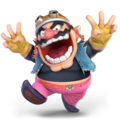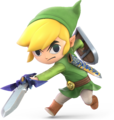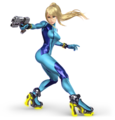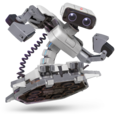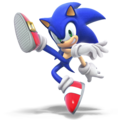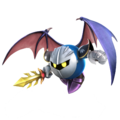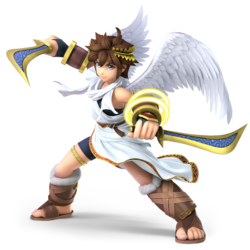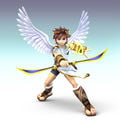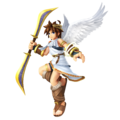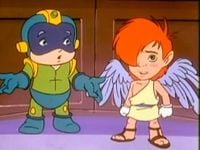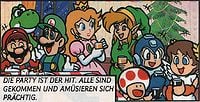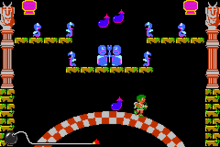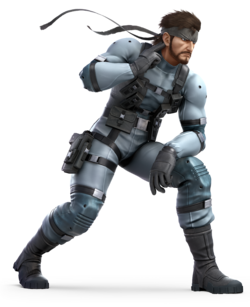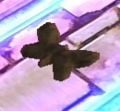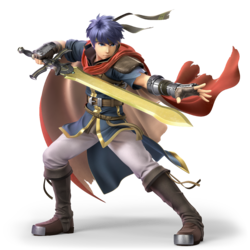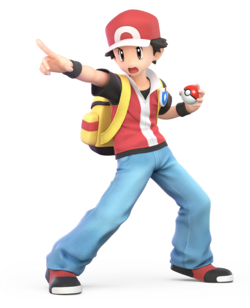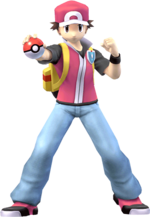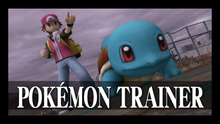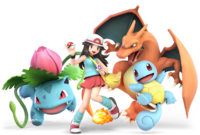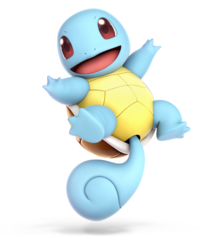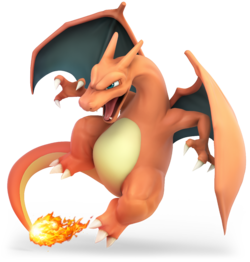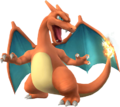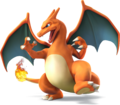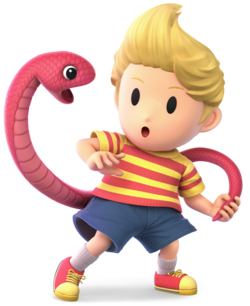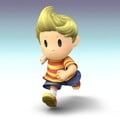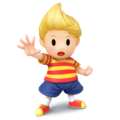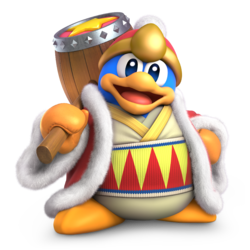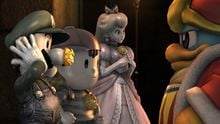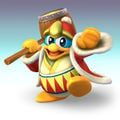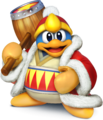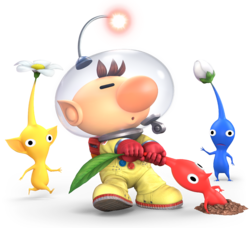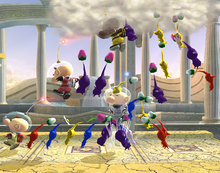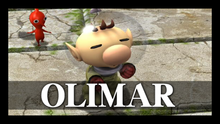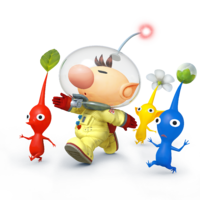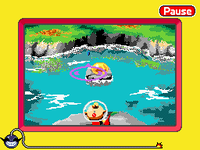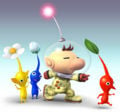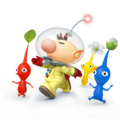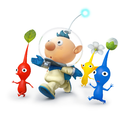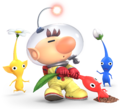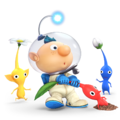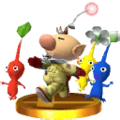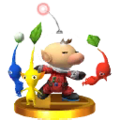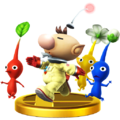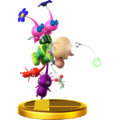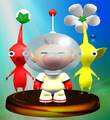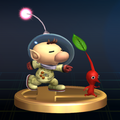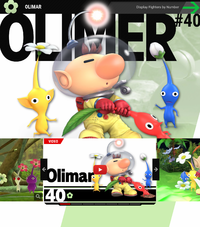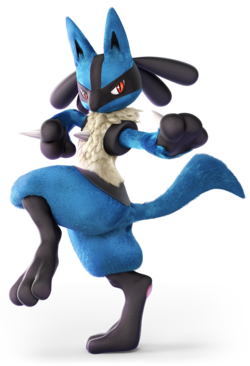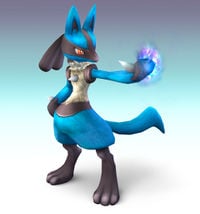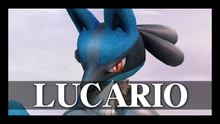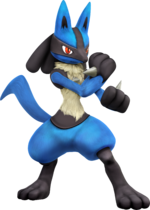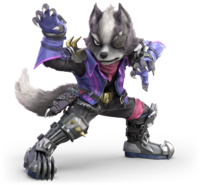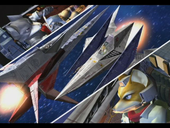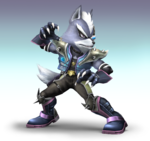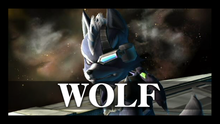List of fighters debuting in Super Smash Bros. Brawl
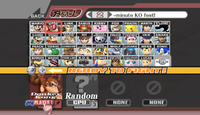
This is a list of Super Smash Bros. series fighters that debuted in Super Smash Bros. Brawl. The page details their role in this series as well as other Super Mario-related media. Characters from the Super Mario franchise are covered in detail on their own articles.
See also:
- List of fighters debuting in Super Smash Bros.
- List of fighters debuting in Super Smash Bros. Melee
- List of fighters debuting in Super Smash Bros. for Nintendo 3DS and Super Smash Bros. for Wii U
- List of fighters debuting in Super Smash Bros. Ultimate
Fighters with articles[edit]
Meta Knight[edit]
- Wikirby article: Meta Knight
- SmashWiki article: Meta Knight
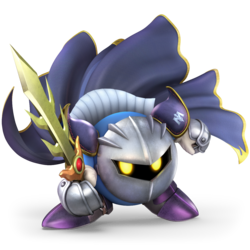
- “Victory is my destiny.”
- —Meta Knight, Super Smash Bros. Brawl
Meta Knight is a recurring anti-hero in the Kirby series, making his debut in Kirby's Adventure. He always wears his metal mask in his series, and usually appears as a rival or a boss Kirby must fight, but has had to team up with him on occasions. He is one of the captains of the Halberd ship. In certain games, after Meta Knight is defeated, his mask splits into two, revealing a face near identical to Kirby's, the main difference being his blue skin tone. He has made crossover appearances with the Super Mario franchise, mostly in the Super Smash Bros. series.
Meta Knight is the only Kirby series character in the Super Smash Bros. series that speaks in full dialogue, aside from Knuckle Joe. In addition, Super Smash Bros. Brawl is the first game in which Meta Knight has a voice actor.
Super Smash Bros. series[edit]
Super Smash Bros. Melee[edit]
Although he does not appear as a playable character, Meta Knight has a trophy in Super Smash Bros. Melee, which can be randomly obtained. The trophy's title is hyphenated as Meta-Knight, referring to the group rather than the individual. The trophy also has a factual error: While his first appearance is listed as Kirby Super Star in September of 1996, his actual first appearance was in Kirby's Adventure in May of 1993.
Super Smash Bros. Brawl[edit]
- SmashWiki article: Meta Knight (SSBB)
Meta Knight appears as a playable fighter in Super Smash Bros. Brawl. He is a small, quick fighter with fast yet weak attacks. Like in the Kirby series, Meta Knight's cape can transform into a pair of wings which not only grant him multiple jumps, but also the ability to glide. His ship, the Halberd, also appears as a stage. Meta Knight's voice actor from Kirby: Right Back at Ya! anime series, Atsushi Kisaichi, provides Meta Knight's voice in the Japanese version of Super Smash Bros. Brawl, while Eric Newsome, who provided Bowser's voice in Super Paper Mario, voices him in other versions.
Meta Knight's special moves are mostly based on attacks that appear in the Kirby series, his own or otherwise. His standard special is Mach Tornado, which causes him to spin around rapidly to deal damage, with the final hit dealing greater damage and knockback. His side special is Drill Rush, in which he charges forward in a spinning motion; if the attack ends in the air, Meta Knight is left in a helpless state, unable to use another move until he lands. His up special is Shuttle Loop, in which he loops around before flying directly up, dealing two hits afterward. His down special is Dimensional Cape, in which he teleports and can attack if the player holds the button; when used in the air, Meta Knight enters a helpless state. His Final Smash is Galaxia Darkness, in which he traps opponents by swiping his cape, then performs a large sword swipe, dealing high damage and knockback to all caught opponents as well as opponents outside of the attack.
Meta Knight is the only character in the game who does not share a victory theme with the other characters from their series, instead using a metal arrangement of the traditional Kirby victory theme. However, this trait would later be shared with other characters in future installments, such as Bowser.
The Subspace Emissary[edit]
Meta Knight's story starts before the events of the actual game, trying to defend the Halberd from Master Hand and the Subspace Army, but was unwittingly prevented from doing as such by King Dedede[1]. His actual first appearance is when he suddenly attacks Marth, who is investigating the activity going on in the Battlefield Fortress. Their duel is interrupted when they are surrounded by Primids, and Meta Knight and Marth see they're both against the Subspace Army and team up. Afterwards, they chase after the Ancient Minister. Meta Knight is disarmed when the Minister disables his wings and forces him to change them into a cape. Out of nowhere, Ike shows up and disarms the Subspace Bomb the Minister had been carrying.
Meta Knight, Marth, and Ike ultimately lose the Ancient Minister near the edge of the Wilds, but they find Galleom in the middle of the desert. After it is defeated, Galleom goes to The Ruined Hall and comes out holding Lucas and the Pokémon Trainer in one hand, with a Subspace Bomb about to go off in its head. Although Lucas manages to free himself and the Trainer, Meta Knight saves them when they almost hit the ground.
Meta Knight and his group find the Halberd fighting the Great Fox above the Glacial Peak, and he climbs the mountain while Marth, Ike, Lucas, and Pokémon Trainer stay behind. As he does this, however, the Ice Climbers race him and beat him to the top. At the summit, Meta Knight discovers the Aura Pokémon Lucario, who challenges him to a duel. The duel ends, the loser gets turned into a trophy and the winner taps on the trophy base to recover him.
After the battle, Meta Knight and Lucario agree to team up and enter the Halberd, where they find Snake thanks to the use of Lucario's Aura. Lucario assures Meta Knight and Snake that they are on the same side and they join forces in taking back the Halberd as Primids approach. The three of them rescue Peach and Zelda from their evil counterparts before heading to the cockpit to find many Mr. Game & Watches controlling the Halberd. Lucario and Snake take care of them with the princesses, Fox, and Falco while Meta Knight takes the helm, regaining his ship.
Eventually, Meta Knight goes into Subspace with the other heroes, although the Halberd is destroyed by the Subspace Gunship as they do this. They find the real mastermind, Tabuu, who fires his Off Waves at them and turns them into trophies. Kirby, however, is revived by one of King Dedede's badges and recovers Meta Knight along with some of the others before they go into the Great Maze to stop Tabuu.
Gallery[edit]
Meta Knight preparing to battle Lucario
Super Smash Bros. for Nintendo 3DS / Super Smash Bros. for Wii U[edit]
- SmashWiki article: Meta Knight (SSB4)
Meta Knight returns as a playable character for Super Smash Bros. for Nintendo 3DS and Super Smash Bros. for Wii U. He, along with other winged characters Pit and Charizard, can no longer glide, either normally or at the end of Shuttle Loop, though Shuttle Loop now hits twice instead. Aside from this, however, Meta Knight's moveset has not been changed. His design has been slightly altered for this installment, giving him metal gauntlets over his gloves. Meta Knight's mobility is improved, but his overall damage output is toned down, his recovery is worsened, his attacks are slower, and their range is decreased.
One of Kirby's alternative palettes is identical to what Meta Knight looks like without his mask (though the palette has yellow eyes), armor and cape in the early Kirby games. In addition, two of Meta Knight's new alternate costumes are based on Dark Meta Knight and Galacta Knight.
Gallery[edit]
Super Smash Bros. Ultimate[edit]
- SmashWiki article: Meta Knight (SSBU)
Meta Knight returns in Super Smash Bros. Ultimate as an unlockable playable character. Meta Knight benefits from universal changes: his mobility is faster, his short hop timing is shortened, the landing lag in his aerials is reduced, the reintroduction of directional air dodging extends his recovery, and he gains the abilities to use any ground attack out of a run and use his aerial attacks on ladders. Meta Knight also receives direct improvements, such as his forward tilt and forward and back aerials having larger hitboxes, and his dash attack and up and down smashes dealing more damage.
Meta Knight can be unlocked by playing VS. matches, being the 38th character to be unlocked. He can also be unlocked by clearing Link's Classic Mode route, being the fourth character unlocked after Simon. A dark puppet fighter of Meta Knight is featured in Hero's reveal trailer, where it, alongside a puppet fighter of Marth, is shown battling Link.
Meta Knight's fighter spirit uses his artwork from Kirby: Planet Robobot.
Classic Mode route[edit]
| Two Sides of the Same Coin | ||||
|---|---|---|---|---|
| Round | Opponent(s) | Rule | Stage | Song |
| 1 | Link, Link (dark costume) | Free-for-All | Bridge of Eldin (Ω) | Hidden Mountain & Forest |
| 2 | Pit, Dark Pit | Reset Bomb Forest | Dark Pit's Theme | |
| 3 | Captain Falcon, Captain Falcon (Blood Falcon costume) | Free-for-All | Port Town Aero Dive | Fire Field |
| 4 | Lucas, Lucas (Claus costume) | New Pork City | Mother 3 Love Theme | |
| 5 | Samus, Dark Samus | Free-for-All | Frigate Orpheon | Multiplayer - Metroid Prime 2: Echoes |
| 6 | Meta Knight (Galacta Knight costume), Meta Knight (Dark Meta Knight costume) | Fountain of Dreams | The World to Win | |
| Final | Master Hand, Crazy Hand | Final Destination | Master Hand / Crazy Hand | |
World of Light[edit]
In the adventure mode, Meta Knight is not seen when the fighters oppose Galeem for the first time. However, he, like every fighter except Kirby, is hit by one of Galeem's beams of light and imprisoned in the World of Light, where a puppet fighter of him is created. While the Meta Knight puppet fighter initially serves Galeem, Dharkon later takes control of the puppet fighter. Kirby's team defeat the Dharkon-controlled Meta Knight puppet fighter and free the real Meta Knight, who joins them against Galeem and Dharkon.
[edit]
Nintendo Monopoly[edit]
Meta Knight is also in both versions of Nintendo Monopoly, where he takes the position of St. Charles Place/Pall Mall, and costs $140.
Super Mario Maker[edit]
Meta Knight appears in his Kirby's Adventure appearance in Super Mario Maker as a Mystery Mushroom costume. It can be unlocked randomly after completing the 100 Mario Challenge on Normal difficulty or higher, or unlocked by scanning any Meta Knight amiibo.
Quotes[edit]
- "Fight me." - Super Smash Bros. Brawl
- "Come!" - Super Smash Bros. Brawl
- "Come back when you can put up a fight." - Super Smash Bros. Brawl
- "You have much yet to learn." - Super Smash Bros. Brawl
- "Know my power!" - Super Smash Bros. Brawl
- "Behold!" - Super Smash Bros. Brawl
- "Victory is my destiny." - Super Smash Bros. Brawl
Audio samples[edit]
| File info |
| File info |
Names in other languages[edit]
| Language | Name | Meaning | Notes |
|---|---|---|---|
| Japanese | メタナイト[?] Meta Naito |
Meta Knight | |
| Chinese | 梅塔骑士[?] Méitǎ Qíshì |
Meta Knight | |
| Chinese (Simplified) | 魅塔骑士[?] Mèitǎ Qíshì |
Meta Knight | |
| Chinese (Traditional) | 魅塔騎士[?] Mèitǎ Qíshì |
Meta Knight | |
| French | Meta Knight[?] | - | |
| German | Meta-Knight[?] | - | |
| Italian | Meta Knight[?] | - | |
| Korean | 메타 나이트[?] Meta Naiteu |
Meta Knight | |
| Russian | Метанайт[?] Metanayt |
Meta Knight | |
| Spanish | Meta Knight[?] | - |
Pit[edit]
- “Man, I don't know whether to fight him or ask him for his autograph.”
- —Pit, on Mario, Super Smash Bros. for Nintendo 3DS and Super Smash Bros. for Wii U
Pit, also known as Kid Icarus on occasion, is a young angel who is the main protagonist of the Kid Icarus series, and the captain of Palutena's army. His most notable appearance alongside Super Mario franchise characters, however, is in the Super Smash Bros. series.
Super Smash Bros. series[edit]
Super Smash Bros. Melee[edit]
Pit, using his design from the original NES game, makes an appearance as an unlockable trophy in Super Smash Bros. Melee.
Super Smash Bros. Brawl[edit]
- SmashWiki article: Pit (SSBB)
Pit appears as a new fighter in Super Smash Bros. Brawl. Pit's design has been significantly altered from his design in the two Kid Icarus games before, based on Masahiro Sakurai's interpretation of what Pit would look like if the Kid Icarus series had continued after Kid Icarus: Of Myths and Monsters.[2]
Pit is voiced by Lani Minella in English, who also voices Lucas, and would later voice Larry, Morton, Wendy and Lemmy in later Super Smash Bros. games and several Super Mario games. In Japanese, he is voiced by Minami Takayama.
Pit carries the Sacred Bow of Palutena, which can fire arrows or split into two blades for up close combat. Because of his wings he is able to jump multiple times, and can also glide. Pit's standard special move in this game is Palutena's Arrow, which lets him shoot an arrow that can be directed as it flies. His side special move is called Angel Ring, during which he spins his bow to deal multiple hits to enemies and deflect projectiles. Pit's down special move is the Mirror Shield, which allows him to reflect any attacks from the front and cause them to deal more damage; it can also protect against physical attacks, though only when the attacker is facing Pit. Finally, his up special move is the Wings of Icarus, which allows him to fly freely for a limited time. Pit's Final Smash, Palutena's Army, summons Centurions on the battlefield to attack opponents by ramming into them. Each Centurion disappears after hitting an opponent, and can also be defeated by attacking them.
Pit is the only fighter in the game that does not appear in his own Final Smash trophy.
The Subspace Emissary[edit]
In the Subspace Emissary of Super Smash Bros. Brawl, Pit joins the story early in the game. He was watching the fight between Mario and Kirby at Midair Stadium when he sees the devastation of the Subspace Army's Subspace Bomb, and is sent by Palutena to go assist the other heroes in defeating the Subspace Army. Palutena gives him the Palutena's Bow. He hurries down to the world, so he can help the other defeat the Subspace Army. He lands on a spot near the Halberd, and has to fight Primids and other Subspace enemies that are appearing. He also finds Mario, transformed into a trophy. He awakens him and the two team up. They soon witness Fox McCloud's Arwing chasing after Halberd.
Upon reaching solid ground, they find the Ancient Minister carrying another Subspace Bomb, but they were unable to reach him, and he gets away. What happens next depends on which princess was rescued.
If Zelda was rescued, Pit destroys the Dark Cannon that False Zelda is about to fire at Link and Yoshi, and subsequently fights her with Mario. They are then attacked by Link and Yoshi, who have mistaken False Zelda as the real Zelda. Otherwise, if Peach was rescued instead, then Pit and Mario are instead targeted by False Peach, who was defeated by Link and Yoshi. Pit and Mario then end up fighting them as well. In both variants, the outcome is similar; the team who defeated the fake princess also defeat the other team, who gets snatched up by King Dedede's Cargo. However, Kirby arrives and revives the defeated team from their trophy forms. Then either Pit or Link blows out the Cargo's engine and all five go after Dedede.
Pit and the others track Dedede down to his castle, but upon entering, they find the throne room in ruins. They explore a nearby cave and eventually find Bowser getting away with the princess that wasn't rescued in the beginning. Pit fires an arrow at Bowser, but this only causes a badge that the princess was wearing to fall off. Bowser escapes to the Halberd.
Pit and the others eventually find the Ancient Minister again, this time in the Wilds. After chasing him for a period of time, the R.O.B.s intervene and detonate the Subspace Bomb that the Minister had been carrying. Pit and the others escape from the blast and reach the Canyon, where they fought hordes from the Subspace Army and meet other heroes. They were eventually joined by even more fighters before entering Subspace, where they met defeat by Tabuu.
Fortunately, King Dedede had designed badges (including the one Kirby ate) to revive fighters from their trophy forms after a set amount of time. With Luigi and Ness by his side, Dedede rescues Pit and most of the others, while Kirby saves the remainder of the team. They then explore the Great Maze before reaching Tabuu for their final battle.
Gallery[edit]
Pit and Mario after defeating Link and Yoshi
Super Smash Bros. for Nintendo 3DS / Super Smash Bros. for Wii U[edit]
- SmashWiki article: Pit (SSB4)
Pit returns as a playable character in Super Smash Bros. for Nintendo 3DS and Super Smash Bros. for Wii U. While Minami Takayama reprised her role in the Japanese version, Pit is now voiced in English by Anthony Del Rio, his voice actor from Kid Icarus: Uprising, which was also developed by Masahiro Sakurai. While part of his moveset is the same as in Super Smash Bros. Brawl, such as Palutena's Arrow (now named Palutena Bow, as the weapon is known in Kid Icarus: Uprising), all of his other special moves as well as his Final Smash have been replaced, mostly to reflect his appearance in Kid Icarus: Uprising. While Pit still has multiple jumps, the gliding mechanic has been removed entirely.
His side special has been changed to the Upperdash Arm, in which Pit dashes forward to uppercut opponents. His down special is now the Guardian Orbitars, which puts up a pair of shields to defend Pit on both sides and push away opponents, though they shatter if attacked enough. His up special is the Power of Flight, which gives Pit a brief burst of height. His Final Smash has been changed to the Three Sacred Treasures, in which he dons the treasures and attacks with light arrows.
In addition, by quickly using Pit's down taunt on the Palutena's Temple stage in Super Smash Bros. for Wii U, it triggers his Smash Taunt, Palutena's Guidance, in which Pit, Palutena, and Viridi appear and talk about one of the opponents, similarly to Snake's codecs in the previous game.
Gallery[edit]
Super Smash Bros. Ultimate[edit]
- SmashWiki article: Pit (SSBU)
Pit returns in Super Smash Bros. Ultimate, as an unlockable playable character, retaining his special moveset from the previous installment. He has a new Final Smash, whereby he rides in the Lightning Chariot and can charge onto any spot on the battlefield using a reticle. This makes him one of the few fighters that have appeared since Super Smash Bros. Brawl to have a different Final Smash in each appearance (along with King Dedede, R.O.B., and Zero Suit Samus). Dark Pit is also specified as an Echo Fighter based on Pit in this game. Pit gains a new quote for his Star KO'd animation. Pit's up tilt is called Anti-Air Attack, while his down aerial is called Under-Arch Slash.
Pit has received many improvements compared to the previous installment, such as faster mobility, reduced short hop timing and landing lag in aerial attacks, the reintroduction of directional air dodging, the ability to dash cancel any ground attack, and the ability to use aerial attacks on ladders. Pit also receives improvements such as decreased ending lag in his up tilt, down tilt, and down throw; increased ability to knock back opponents in his dash attack, forward smash, back aerial attack, and down aerial attack; and increased damage for his standard, forward, and up aerial attacks.
In the Adventure mode, both Pit and Dark Pit are present when the fighters oppose Galeem for the first time. The former is seen before Galeem unleash the large laser attack; Palutena then tries to reflect Galeem's attack while granting the Power of Flight to both Pit and Dark Pit, but fails and is eliminated, cutting off Pit and Dark Pit's flight and causing them to fall to Galeem's attack as well.
Pit's fighter spirit uses his artwork from Kid Icarus: Uprising. He also makes an appearance in two primary spirits.
Classic Mode route[edit]
| Fighting for the Goddess! | ||||
|---|---|---|---|---|
| Round | Opponent(s) | Rule | Stage | Song |
| 1 | Dark Samus | Brinstar | Underworld | |
| 2 | Bowser, Bowser Jr. | Find Mii (Ω) | Boss Fight 1 - Kid Icarus: Uprising | |
| 3 | Ganondorf | Gerudo Valley | Magnus's Theme | |
| 4 | Dark Pit | Reset Bomb Forest | Dark Pit's Theme | |
| 5 | Bayonetta | Umbra Clock Tower | Hades's Infernal Theme | |
| 6 | Palutena | Team Battle (Ally: Dark Pit) |
Palutena's Temple (Battlefield) | Destroyed Skyworld |
| Final | Master Hand, Crazy Hand | Team Battle (Ally: Dark Pit) |
Final Destination | Master Hand / Crazy Hand |
Gallery[edit]
[edit]
Tetris[edit]
The results screen for the NES version of Tetris features Pit as part of a band composed of himself, Donkey Kong, Link, Samus, Mario, Luigi, Princess Peach, and Bowser. He is playing the harp. Pit in particular appears when the player has completed height 0 of Game B's ninth level.
Captain N: The Game Master[edit]
Pit, referred to as Kid Icarus, appeared as a recurring character in the American television series, Captain N: The Game Master.
"Super Mario: Die Bescherung"[edit]
Pit makes a minor appearance in the Club Nintendo comic Super Mario: Die Bescherung. In this comic strip, Pit is one of the invited guests that Mario had invited over for a Christmas party that he is hosting. Within the comic, Pit is seen alongside various characters including Mario, Luigi, Princess Toadstool, Toad, Yoshi, Link, and Mega Man. His appearance resembles his artwork from Of Myths and Monsters.
WarioWare series[edit]
WarioWare: Twisted![edit]
Pit appears as part of the Kid Icarus microgame in WarioWare: Twisted!, based upon the NES game. The objective is to tilt the Game Boy Advance so that Pit can avoid the attacks from the Eggplant Wizards.
WarioWare: Smooth Moves[edit]
In WarioWare: Smooth Moves, Pit makes an appearance as one of the 8-bit characters performing in the Opening Night microgame, during stages two and three.
WarioWare: D.I.Y. Showcase[edit]
Pit appears in the Kid Icarus microgame in international versions of WarioWare: D.I.Y. Showcase, in which players must break the pots and collect the items in a room in order to win.
WarioWare Gold[edit]
Pit appears in another microgame also titled Kid Icarus, where he must shoot Medusa's eye three times.
Super Mario Maker[edit]
By tapping the Pit amiibo to the Wii U GamePad in Super Mario Maker, the player will unlock a Mystery Mushroom that gives Mario a costume based on Pit to use in the Super Mario Bros. graphical style. Rather than use his original Kid Icarus sprite, the sprite for this game is a new one based on his design in Kid Icarus: Uprising. When in use, the costume also replaces some sound effects with sound effects from the Famicom Disk System version of Kid Icarus.
The Super Mario Bros. Movie[edit]
Pit makes a cameo in The Super Mario Bros. Movie, early in the film when Mario is in Brooklyn playing Kid Icarus on his NES. The Kid Icarus cartridge, featuring Pit, also appears in the credits.
Quotes[edit]
- "Great Palutena, victory is ours!" - Super Smash Bros. Brawl
- "You're not ready yet!" - Super Smash Bros. Brawl
- "Too easy!!" - Super Smash Bros. Brawl
- "I'm done for!" - Super Smash Bros. Brawl
- "You can't defeat me!" - Super Smash Bros. Brawl
- "All troops, move out!" - Super Smash Bros. Brawl
- "Nice try!" - Super Smash Bros. Brawl
- "I'm finished!" - Super Smash Bros. for Nintendo 3DS / Wii U
- "That all you got?" - Super Smash Bros. for Nintendo 3DS / Wii U
- "It's game over for you!" - Super Smash Bros. for Nintendo 3DS / Wii U
- "Victory!" - Super Smash Bros. for Nintendo 3DS / Wii U
- "What's up now?" - Super Smash Bros. for Nintendo 3DS / Wii U
- "That was easy!" - Super Smash Bros. for Nintendo 3DS / Wii U
- "Dash Upper!" - Super Smash Bros. for Nintendo 3DS / Wii U (Japanese version only)
- "Stay back!" - Super Smash Bros. for Nintendo 3DS / Wii U
- "Ha-ha!" - Super Smash Bros. for Nintendo 3DS / Wii U
- "Equipped!" - Super Smash Bros. for Nintendo 3DS / Wii U
- "Bye, now!" - Super Smash Bros. for Nintendo 3DS / Wii U
- "Three Sacred Treasures!" - Super Smash Bros. for Nintendo 3DS / Wii U
- "I never learned how to read!" - Super Smash Bros. Ultimate
- "We'll win this. I know we will!" - Super Smash Bros. Ultimate (World of Light)
- "Lightning Chariot! Phos! Lux! Let's go!" - Super Smash Bros. Ultimate
Audio samples[edit]
| File info |
| File info |
| File info |
Names in other languages[edit]
| Language | Name | Meaning | Notes |
|---|---|---|---|
| Japanese | ピット[?] Pitto |
Pit; based on「キューピット」(Kyupitto, "Cupid") | |
| Chinese | 皮特[?] Pítè |
Pit | |
| 彼特[?] Bǐtè |
Super Smash Bros. Ultimate | ||
| Finnish | Kid Icarus[citation needed] | - | |
| Icarus[citation needed] | |||
| Korean | 피트[?] Piteu |
Pit | |
| Russian | Пит[?] Pit |
- | |
| Spanish | Pit[?] | - |
Notes[edit]
- Pit's redesign from Super Smash Bros. Brawl was re-used in Kid Icarus: Uprising for the Nintendo 3DS developed by Sora Ltd., who also developed Super Smash Bros. Brawl.
- In the Japanese version of the games, Pit occasionally says "Yarare-chatta..." when he is KO'd; a reference to the Game Over text in the NES Kid Icarus. In the international versions of Super Smash Bros. Brawl, however, this is translated directly to "I'm done for...", making it break the reference. This is changed to "I'm finished!" in the subsequent games; as how the aforementioned Game Over screen is translated in the international release of Kid Icarus.
- Similarly, Pit's Star KO line in Super Smash Bros. Ultimate, "I never learned how to read!", is a reference to a line of dialogue he uses in Kid Icarus: Uprising. This is not present in the Japanese version, which simply uses his Star KO scream in Super Smash Bros. for Nintendo 3DS and Super Smash Bros. for Wii U.
Snake[edit]
- SmashWiki article: Solid Snake
- “You're kidding, right? It's Mario.”
- —Snake, on Mario, Super Smash Bros. Brawl
Solid Snake (real name: David) is the main character of Konami's Metal Gear series of games. He is one of the results of the "Les Enfants Terribles" project, a government project to create clones of the renowned soldier "Big Boss", and is constantly given the mission of deprogramming the various versions of the bipedal nuclear-armed tank called Metal Gear. Snake has appeared in the Super Smash Bros. series, debuting in Super Smash Bros. Brawl and returning in Super Smash Bros. Ultimate. According to Masahiro Sakurai, Metal Gear series creator Hideo Kojima originally asked him to include Snake in Super Smash Bros. Melee, but as the game was too far into development at that point, he could not be included and was instead added into the next game.[3] Like in the Metal Gear series at the time of release, Snake is voiced by Akio Ohtsuka in the Japanese version, and by David Hayter in the English version. Although he is identified as Solid Snake, his actual appearance in the Super Smash Bros. series is technically a mixture between Solid Snake himself and his "father", Big Boss, or more accurately his Naked Snake self from Snake Eater. He is one of only three characters in the series to come from a franchise rated M in the Americas, with the others being Bayonetta and Joker.
Snake fights using a combination of explosives and hand-to-hand combat. Snake's special moves are Hand Grenade, an explosive that can be thrown at various distances, Remote Controlled Missile, a guided missile that rockets wherever it is aimed, Cypher, a flying security drone that flies Snake up, and C4, a sticky explosive that can be mounted on various surfaces. Snake can also deal a small amount of damage with his taunts, which involve him hiding in and coming out his cardboard box, which can also be thrown like an item to deal 1-2% of damage.
Additionally, Snake has access to a unique series of taunts, which spawns in a cardboard box that Snake retreats into. When Snake exits the box at the end of the taunt, it can hit an opponent for a small amount of damage (1%~2%.) The cardboard box is an iconic trademark of the Metal Gear series, appearing in most games as a way to sneak by enemies.
Super Smash Bros. Brawl[edit]
- SmashWiki article: Snake (SSBB)
Snake's appearance in Super Smash Bros. Brawl was revealed from the very first trailer premiered in May 2006. His reveal was very noteworthy, marking the first time a third-party character had debuted in the series. He uses his general appearance from Metal Gear Solid 2: Sons of Liberty, though also taking elements from Big Boss in Metal Gear Solid 3: Snake Eater, such as the facial hair and his alternate costumes based upon the camouflage suits. Snake is the third heaviest character in the game, even surpassing characters such as King Dedede, Ganondorf and Charizard, and only behind Bowser and Donkey Kong. His Final Smash is Grenade Launcher, in which he jumps onto a helicopter and fires grenades on the stage.
By doing a split-second down taunt on Shadow Moses Island, Snake performs a Smash Taunt in which he contacts one of several Metal Gear characters via codec to analyze the opponent, specifically Mei Ling, Otacon, and Colonel Roy Campbell (as well as Slippy Toad, who appears only in the conversation for Falco). Below are several notes on his codec conversations regarding fighters related to the Super Mario franchise:
- In the codec call about Yoshi, Snake suggests capturing him to "see what [he] tastes like", which is Naked Snake's typical response to animal life in Metal Gear Solid 3.
- In the codec call about Peach, Snake, after criticizing Peach for constantly letting herself get kidnapped instead of actually doing something to prevent it, is accused by Mei Ling of not getting many dates, alluding to how he constantly has trouble maintaining a constant relationship with various women, notably stiffing Holly White in the ending to Metal Gear 2: Solid Snake and his leaving Meryl Silverburgh sometime between Metal Gear Solid and Metal Gear Solid 2: Sons of Liberty.
- In the codec call about Donkey Kong, Snake refers to him as being a "chip off the old block" upon learning about how he is the most recent Donkey Kong after inheriting the title from Cranky Kong and continuing the tradition of being a rival to Mario, alluding to how Snake himself inherited his title from his "father", Big Boss/Naked Snake, who himself had inherited the title of "Boss" from his mentor and mother figure, The Boss.
The Subspace Emissary[edit]
Snake's cardboard box is first seen in a cutscene after clearing The Research Facility, but Snake himself does not show until later. Once he is ready to begin his mission, Snake reveals himself to the player and begins sneaking around the Halberd Battleship. He hears a sound approaching him as he is walking around, and quickly hides in his box as Lucario and Meta Knight pass by him. However, Lucario turns back around, and sees through the box with his Aura. He picks up the box, much to Snake's surprise. Snake readies himself for battle, but Lucario notices Primids coming with his Aura. Lucario then tells Snake to follow him, and they form a party. Later, they reach a room in which there are two cages with the trophies of Peach and Zelda, and the purple Shadow Bugs make dark versions of the two. The team fights the evil princesses and defeats them, rescuing the real Princesses out of the cages they are kept in.
As Meta Knight and Lucario leave, Snake tells the two girls to stay where they are and then proceeds to catch up. Lucario, Meta Knight, and Snake have gone to the bridge to find that there are a lot of Mr. Game & Watches piloting the ship. Snake runs and throws them all out the window, making them all land on the deck of the Halberd and turn into Shadow Bugs. Snake and Lucario then jump out the window to see the Shadow Bugs create Duon.
Later, when the team encounters Tabuu, Snake and the rest are transformed into trophies. If Snake is rescued during the Great Maze, he will join the team and help take on Tabuu.
Gallery[edit]
A C4 placed on Wario
Snake in The Subspace Emissary
Lucario finding Snake in his cardboard box
Super Smash Bros. Ultimate[edit]
- SmashWiki article: Snake (SSBU)
While Snake was completely absent from Super Smash Bros. for Nintendo 3DS and Super Smash Bros. for Wii U, he returns in Super Smash Bros. Ultimate as a playable character after a decade long absence from the series. His basic moveset is mostly unchanged from Super Smash Bros. Brawl; for his down smash, however, he now executes a forward and backward kick similar to Captain Falcon instead of planting a mine in the ground. Additionally, for his Final Smash, the player controls an on-screen reticle to lock onto opponents by hovering it over them, after which Snake sends out heat-seeking missiles to attack them. Snake's series emblem is now the exclamation mark that would appear when a character is alerted in the original series, replacing the FOX Unit logo (which is also the former logo for Kojima Productions) following Kojima's departure from Konami. His home stage Shadow Moses Island also makes a reappearance, as well as his codec conversations, albeit the recycled ones from Super Smash Bros. Brawl (with the exception of the conversation on Link no longer mentioning the Clawshot) and excluding those for fighters that do not appear in that game.
Snake's mobility has been significantly improved, sporting faster walking, dashing, air, and fast falling speeds, while his initial dash is also improved. Like all other characters, Snake's aerial attacks have much less landing lag, while more of his attacks have faster startup lag, and less end lag. Snake, like all other characters, can directionally air dodge, while being able to use any ground attack out of a run and any of his aerial attacks on ladders. Snake's up and down tilts, up smash's mortar shell, and up throw have their damage outputs improved; however, his standard attack, forward tilt, neutral and down aerials, and down throw have their damage decreased. Snake is also significantly lighter than in Super Smash Bros. Brawl, now only being heavier than Link, Yoshi, Captain Falcon, Mii Gunner and Min Min, lighter than Wario, Ike, Ridley, Simon and Richter while weighing the same as R.O.B. and Banjo & Kazooie. Lastly, some of his attacks have had their range lowered.
In the World of Light, Snake is seen when the fighters oppose Galeem for the first time; in his case, he hid himself in his cardboard box to dodge Galeem's attack of lasers, but fails and is captured by Galeem and used to create puppet fighters.
Classic Mode route[edit]
| Weapons and Equipment OSP | ||||
|---|---|---|---|---|
| Round | Opponent(s) | Rule | Stage | Song |
| 1 | Inkling Girl, Inkling Boy | Moray Towers | Encounter | |
| 2 | Diddy Kong | Kongo Falls | Theme of Tara | |
| 3 | Pit | Shadow Moses Island (Battlefield) | Theme of Solid Snake | |
| 4 | Link | Jungle Japes | Snake Eater | |
| 5 | Samus ×2, R.O.B. ×2 | Horde Battle | Norfair | Main Theme - METAL GEAR SOLID PEACE WALKER |
| 6 | Snake | Shadow Moses Island | MGS4 ~Theme of Love~ | |
| Final | Galleom | Boss Battle - Super Smash Bros. Brawl | ||
Gallery[edit]
A C4 placed on Bowser Jr.
Quotes[edit]
- "Kept you waiting, huh?" - Super Smash Bros. Brawl
- "Tasty!" - Super Smash Bros. Brawl
- "Good!" - Super Smash Bros. Brawl
- "Not even close!" - Super Smash Bros. Brawl
- "Colonel, mission accomplished." - Super Smash Bros. Brawl
- "This is Snake. I'm done here." - Super Smash Bros. Brawl
Audio samples[edit]
| File info |
| File info |
Names in other languages[edit]
| Language | Name | Meaning | Notes |
|---|---|---|---|
| Japanese | ソリッド・スネーク[?] Soriddo Sunēku |
Solid Snake | |
| French | Solid Snake[?] | - | |
| Korean | 스네이크[?] Seuneikeu |
Snake | |
| Russian | Снейк[?] Sneyk |
Snake | |
| Spanish | Solid Snake[?] | - |
In the Chinese version of Super Smash Bros. Ultimate, Snake's name is untransliterated and written in English. This also applies to Mr. Game & Watch, Simon and Richter Belmont, Cloud, Bayonetta, Inkling, and Joker for both the Simplified and Traditional Chinese versions, as well as Ryu and Ken in the Traditional Chinese and Korean versions.
Ike[edit]
- “I fight for my friends.”
- —Ike, Super Smash Bros. Brawl
Ike is the protagonist in two games of the Fire Emblem series, debuting in Fire Emblem: Path of Radiance, the series' ninth installment. In his home series, Ike is the leader of the Greil Mercenaries, who are drawn into two wars spanning the continent of Tellius. With the help of his companions, Ike acquires the sacred sword Ragnell and brings peace to Tellius, ending hostilities between its inhabitant beorc and laguz races in the process.
He appears as a playable fighter in the Nintendo-crossover fighting game, Super Smash Bros. Brawl, and returned for its successors, Super Smash Bros. for Nintendo 3DS, Super Smash Bros. for Wii U, and Super Smash Bros. Ultimate. Ike is the third Fire Emblem character to appear in the Super Smash Bros. series, after Marth and Roy. Ike is a very powerful fighter - one of the strongest, but as a downside, he is quite heavy and slow.
Super Smash Bros. series[edit]
Super Smash Bros. Brawl[edit]
- SmashWiki article: Ike (SSBB)
Ike appears as a playable character in Super Smash Bros. Brawl, using his appearance in Fire Emblem: Path of Radiance. He fights using the two-handed longsword Ragnell, which gives his attacks power and range, but as a result he is slower and heavier than most characters. Ike was not originally intended to be in the game from the start; instead, Masahiro Sakurai had created a template for a slow but powerful swordsman. As he also wanted to include a new Fire Emblem character, it was decided that Ike, in addition to being the protagonist of the latest games in the Fire Emblem series at the time, would be a good fit for the concept. Ike is voiced by Jason Adkins in English, and by Michihiko Hagi in Japanese, his respective voice actors since the release of Fire Emblem: Path of Radiance. This also makes him the first Fire Emblem character in the series to be given an English voice actor.
Ike's neutral special move is Eruption, in which he plunges his sword into the ground to create an explosion. His side special move is Quick Draw, which has Ike charge a sword slash that sends him directly forward. His up special is Aether, in which Ike throws his sword into the air and slams back into the ground. His down special move is Counter, which has Ike deal a counterattack if he is hit. His Final Smash is Great Aether, which has him slash any nearby opponents into the air, where he repeatedly attacks them before slamming them back into the ground.
The Subspace Emissary[edit]
Ike makes his debut in The Subspace Emissary near the end of The Battlefield Fortress. During the story, both Marth and Meta Knight fail to stop the Ancient Minister from carrying another Subspace Bomb to another location in the trophy world. Hope seems lost for the two, until, out of nowhere, the Ragnell sword begins hovering behind the Ancient Minister, and Ike continues to use Aether on the Subspace Bomb, breaking it and deactivating it, making the Ancient Minister flee. The three warriors continue through the wasteland, finally reaching the Ancient Minister, but are unable to do anything as he floated over a cliff.
The three continue to dash onwards through The Wilds, after seeing Galleom in its tank form. Galleom transforms into its main form after meeting the swordsmen. Ike, Marth, and Meta Knight face off against Galleom afterwords, and then continue into The Canyon. After Meta Knight had left the group after Galleom was defeated a second time, Ike, alongside Pokémon Trainer, Lucas, and Marth, are seen fighting many Primids, now with the Ice Climbers. The five "warriors" are then seen (Mario, Pit, Kirby, Link, and Yoshi) in the background, jumping off from a bluff to help fight off the army. After awhile, Ike, alongside many others, are flown into Subspace, where he and all others are turned into trophies. However, King Dedede, Ness, and Luigi recover him, and others (Kirby also helps afterwards). He and the others are then pitted against The Great Maze, and then the creature whom turned the heroes into trophies, Tabuu.
Gallery[edit]
Super Smash Bros. for Nintendo 3DS / Super Smash Bros. for Wii U[edit]
- SmashWiki article: Ike (SSB4)
Ike returns as a veteran fighter in Super Smash Bros. for Nintendo 3DS and Super Smash Bros. for Wii U. His design has been changed to be his appearance as a Hero in Fire Emblem: Radiant Dawn. While Ike's moveset is no different from the previous game, most of his attacks that use fire use blue flames rather than the red seen in Super Smash Bros. Brawl, referencing his blessing by the goddess Yune at the end of Fire Emblem: Radiant Dawn, during which his sword is cloaked in blue fire. Ike receives faster movement and attack speed, in exchange for his overall damage output being slightly toned down.
Gallery[edit]
Super Smash Bros. Ultimate[edit]
- SmashWiki article: Ike (SSBU)
Ike reappears in Super Smash Bros. Ultimate as a playable character, where this time, players can choose to play as his Fire Emblem: Path of Radiance or Fire Emblem: Radiant Dawn appearance. His voice also changes slightly depending on which appearance is used, which is provided by his voice actor from Fire Emblem Heroes, Greg Chun, replacing Jason Adkins from previous Super Smash Bros. installments. Ike benefits greatly from universal changes: his mobility is even faster, his short hop timing is greatly reduced, his aerials have less landing lag, his recovery is extended by the reintroduction of directional air dodges, and his offensive play is aided by the abilities to use any ground attack out of a run and use his aerials on ladders.
On a side note, as with several other returning fighters, Ike's (as well as Marth and Roy's) victory theme has been sped up compared to the previous installments.
Classic Mode route[edit]
Ike's Classic Mode route involves fighting characters in dark-colored alternate costumes (except if they are dark-colored by default). This represents his relationship with the Black Knight in his own games.
| The Black-Clad Warriors | ||||
|---|---|---|---|---|
| Round | Opponent(s) | Stage | Song | |
| 1 | Meta Knight, Kirby | Fountain of Dreams | Meta Knight's Revenge | |
| 2 | Morton, Greninja, Sonic | Spear Pillar | Knight of the Wind | |
| 3 | Dark Pit | Reset Bomb Forest | Dark Pit's Theme | |
| 4 | Bayonetta | Umbra Clock Tower | One Of A Kind | |
| 5 | Giant Mr. Game & Watch | Luigi's Mansion (Battlefield) | On the Hunt -Gloomy Manor Ver.- (Instrumental) | |
| 6 | Link, Toon Link | Bridge of Eldin | Hyrule Castle (Outside) | |
| Final | Master Hand, Crazy Hand (intensity 7.0 or higher) | Final Destination | Master Hand Master Hand / Crazy Hand (intensity 7.0 or higher) | |
[edit]
Super Mario Maker[edit]
Ike appears as a Mystery Mushroom costume in Super Mario Maker, using the same sound effects from Fire Emblem: Shadow Dragon and the Blade of Light as the other Fire Emblem character costumes.
Quotes[edit]
- "Prepare yourself!"
- "Aether!"
- "Great... AETHER!"
- "You're open!"
- "Gotcha!"
- "I fight for my friends."
- "You'll get no sympathy from me."
Audio samples[edit]
| File info |
| File info |
| File info |
| File info |
Names in other languages[edit]
| Language | Name | Meaning | Notes |
|---|---|---|---|
| Japanese | アイク[?] Aiku |
Ike | |
| Chinese | 艾克[?] Àikè |
Ike | |
| Korean | 아이크[?] Aikeu |
Ike | |
| Russian | Айк[?] Ayk |
Ike | |
| Spanish | Ike[?] | Pronounced as [ˈi.ke], instead the English [aɪk], since Super Smash Bros. Brawl. |
Notes[edit]
- If Ike grabs someone while he is a giant and does a pummel, the grabbed opponent instantly breaks free from the grab, regardless of their damage. This also happens if Ike grabs someone while tiny.
Pokémon Trainer[edit]
- Bulbapedia article: Pokémon Trainer (Super Smash Bros.)
- SmashWiki article: Pokémon Trainer
- This section is about the character in Super Smash Bros. Brawl. For other uses of "Trainer", see Trainer.
- “Take this! Triple Finish!”
- —Pokémon Trainer, Super Smash Bros. Brawl
A Pokémon Trainer is a human that catches, trains, cares for, and battles alongside Pokémon. The player character in the Pokémon series is fittingly a Pokémon Trainer, as are most humans in the series.
Red, the player character of the Pokémon series' first generation and male player character of Pokémon FireRed Version and Pokémon LeafGreen Version, makes a playable appearance in Super Smash Bros. Brawl as a default fighter and (alongside his female counterpart Leaf) in Super Smash Bros. Ultimate as an unlockable fighter. However, Red and Leaf are referred to simply as "Pokémon Trainer", and differ from other fighters by issuing commands to three Pokémon (Squirtle, Ivysaur, and Charizard) to fight on their behalf.
Super Smash Bros. Brawl[edit]
- SmashWiki article: Pokémon Trainer (SSBB)
Red, albeit known simply as "Pokémon Trainer", is the first playable Pokémon representative in the Super Smash Bros. series who is not an actual Pokémon. Though a selectable character, he is not an actual fighter, instead commanding any of his three Pokémon in the background of the stage, his team consisting of Squirtle, Ivysaur, and Charizard. The only move the trainer performs is Pokémon Change, which allows the player to switch out his three Pokémon at will throughout the battle. He also automatically switches Pokémon whenever one is KO'd. The Pokémon also run on a stamina system that weakens them, as their stamina decreases the longer they are out on the field. Their Final Smash is Triple Finish, which has the trainer send out all three Pokémon at once to attack. In English, the Pokémon Trainer is voiced by Michele Knotz.
Pokémon Trainer is one of the few fighters to only get five alternate costumes in Super Smash Bros. Brawl, instead of the usual six. This is also shared with fellow Pokémon representatives Lucario and Jigglypuff, as well as Sonic. One of Pokémon Trainer's alternative costumes has the same colors as another Pokémon Trainer: Brendan's outfit from Pokémon Emerald.
For unknown reasons, Pokémon Trainer's name is announced differently between the English and Japanese versions of Super Smash Bros. Brawl. This trait is shared with Fox McCloud in the original Super Smash Bros.
The Subspace Emissary[edit]
In The Subspace Emissary, he allies with Lucas, who helps him find his Charizard and Ivysaur. The two also encounter Wario and a large Subspace Army robot, Galleom. They are saved from the robot's detonation by Meta Knight, and they team up with him, Marth, and Ike afterwards. When encountering a huge Subspace Army group on the foothills of a mountain (Meta Knight has left to retake the Halberd), they are saved by Mario and his team (Link, Yoshi, Pit, and Kirby).
Gallery[edit]
Super Smash Bros. for Nintendo 3DS / Wii U[edit]
In Super Smash Bros. for Nintendo 3DS and Super Smash Bros. for Wii U, transforming during battle is omitted, so Charizard was made into a separate character, while the Pokémon Trainer, Squirtle, and Ivysaur are no longer playable. They appear as collectable trophies, however.
Super Smash Bros. Ultimate[edit]
- SmashWiki article: Pokémon Trainer (SSBU)
Pokémon Trainer returns as a playable character in Super Smash Bros. Ultimate. With the removal of the stamina system, one can play as Squirtle, Ivysaur, or Charizard for an extended period of time with no penalty. This time, a female Pokémon Trainer variant can also be used, akin to Villager, Wii Fit Trainer, Robin, Corrin and Inkling, and like them, is statistically identical to the male one. She is represented by Leaf, the female player character of Pokémon FireRed and LeafGreen Versions. In English, Billy Bob Thompson (who also voices Greninja) voices the male Pokémon Trainer, while Kate Bristol voices the female. In Japanese, Tomoe Hanba voices the male trainer and Wakana Minami (previously known by her stage name, Wakana Kingyo) voices the female trainer. A majority of the male Pokémon Trainer's quotes are also different from Super Smash Bros. Brawl as well.
Both Pokémon Trainers' fighter spirits use their artwork from this game.
Classic Mode route[edit]
| The Future Champion | ||||
|---|---|---|---|---|
| Round | Opponent(s) | Stage | Song | |
| 1 | Pikachu | Pokémon Stadium | Main Theme - Pokémon Red & Pokémon Blue (Melee) | |
| 2 | Jigglypuff | Battle! (Trainer Battle) - Pokémon X / Pokémon Y | ||
| 3 | Lucario | Unova Pokémon League | Battle! (Trainer) - Pokémon Sun / Pokémon Moon | |
| 4 | Incineroar | Kalos Pokémon League | Battle! (Elite Four) / Battle! (Solgaleo/Lunala) | |
| 5 | Greninja | Pokémon Stadium 2 | Battle! (Champion) - Pokémon X / Pokémon Y | |
| 6 | Pokémon Trainer (opposite gender) | The Battle at the Summit! | ||
| Final | Mewtwo Master Hand |
Final Destination | Pokémon Red / Pokémon Blue Medley Master Hand | |
Portrayals[edit]
- English: Michelle Knotz (Super Smash Bros. Brawl) / Billy Bob Thompson (male; Super Smash Bros. Ultimate) / Kate Bristol (female)
- Japanese: Tomoe Hanba (male) / Wakana Minami (female)
- French: Virginie Demians (Super Smash Bros. Brawl) / Emilie Guillaume (male; Super Smash Bros. Ultimate) / Elisabeth Guinand (female)
- Spanish: Isabel Navarro (Super Smash Bros. Brawl) / Rodri Martín (male; Super Smash Bros. Ultimate) / Tania Ugía (female)
- German: Dina Kuerten (Super Smash Bros. Brawl) / Maximilian Belle (male; Super Smash Bros. Ultimate) / Lea Kalbhenn (female)
- Italian: Francesca Giudice (Super Smash Bros. Brawl) / Tania De Domenico (male; Super Smash Bros. Ultimate) / Giada Bonanomi (female)
- Korean: Lee Sun (Super Smash Bros. Brawl only)
Names in other languages[edit]
| Language | Name | Meaning | Notes |
|---|---|---|---|
| Japanese | ポケモントレーナー[?] Pokemon Torēnā |
Pokémon (Pocket Monster) Trainer | |
| Chinese | 寶可夢訓練家 (Traditional) 宝可梦训练家 (Simplified)[?] Bǎokěmèng Xùnliànjiā |
Pokémon Trainer | |
| Dutch | Pokémon Trainer[?] | - | |
| French | Dresseur de Pokémon (if male) Dresseuse de Pokémon (if female)[?] |
Pokémon Trainer -e is a feminine suffix |
|
| German | Pokémon-Trainer (if male) Pokémon-Trainerin (if female)[?] |
Pokémon Trainer -in is a feminine suffix |
|
| Italian | Allenatore di Pokémon (if male) Allenatrice di Pokémon (if female)[?] |
Pokémon Trainer -ice is a feminine suffix |
|
| Korean | 포켓몬 트레이너[?] Poketmon Teureineo |
Pokémon Trainer | |
| Russian | Тренер покемонов[?] Trener pokemonov |
Pokémon Trainer | |
| Spanish | Entrenador Pokémon (if male) Entrenadora Pokémon (if female)[?] |
Pokémon Trainer -a is a feminine suffix |
Squirtle[edit]
- Bulbapedia article: Squirtle (Super Smash Bros.)
- SmashWiki article: Squirtle
- “Squirtle is one of three Pokémon you can get from Professor Oak in Pokémon Red and Blue. Squirtle was one of the few Water-type Pokémon you could get until you got a Fishing Rod.”
- —Tips, Super Smash Bros. Ultimate
Squirtle is a Water-type Pokémon and one of the three starting Pokémon in Pokémon Red Version and Pokémon Green Version, later localized as Pokémon Red Version and Pokémon Blue Version. Its name is a portmanteau of "squirt" and "turtle." In the Pokémon series, it evolves into Wartortle and later into Blastoise.
Mario Artist: Paint Studio[edit]
Artwork of Squirtle from Pokémon Red Version and Pokémon Green Version can be used as a stamp in Mario Artist: Paint Studio.
Super Smash Bros. series[edit]
Super Smash Bros. Melee[edit]
In Super Smash Bros. Melee, Squirtle is the first Pokémon to appear on the Poké Floats stage. There is also a Squirtle trophy, obtainable in the Lottery or when it appears at random in the game's single-player modes.
Super Smash Bros. Brawl[edit]
- SmashWiki article: Squirtle (SSBB)
Squirtle is a playable character in Super Smash Bros. Brawl. However, it takes commands from the Pokémon Trainer, who is the real mastermind behind Squirtle's actions. The other two Pokémon used by Pokémon Trainer are Ivysaur and Charizard. When the Pokémon Trainer uses Pokémon Change, his down special move, he returns Squirtle and sends out Ivysaur next, but when used with Charizard, Squirtle is sent out. Squirtle is the lightest of the group, but also attacks the quickest.
Squirtle's special moves are derived from Water-type attacks from the Pokémon series. Its standard special move is Water Gun, in which it charges an attack to spit water at opponents. Its side special is Withdraw, which causes it to charge directly ahead in its shell. Its up special is Waterfall, which causes Squirtle to leap into the air on a stream of water.
Like all Pokémon of the Pokémon Trainer, Squirtle shares the damage meter with the other Pokémon and has a special stamina stat. It is there to regulate the Pokémon changes. When the player changes Pokémon rarely or too often, the stamina of the Pokémon runs low. Squirtle can also wall jump, and has the ability to stick to walls. Finally, Squirtle has a similar type effectiveness to its games of origin, making it take more damage from grass attacks but less from fire attacks. Squirtle is voiced by Michele Knotz, who also does the voice of the Pokémon Trainer.
The Subspace Emissary[edit]
In the Subspace Emissary, the Pokémon Trainer starts out with only Squirtle. Eventually, he earns Ivysaur and Charizard.
Gallery[edit]
Super Smash Bros. for Nintendo 3DS / Wii U[edit]
Although Squirtle does not return as a playable character in Super Smash Bros. for Nintendo 3DS and Super Smash Bros. for Wii U, it appears as a trophy in both versions of the game.
Super Smash Bros. Ultimate[edit]
- SmashWiki article: Squirtle (SSBU)
Squirtle returns alongside the Pokémon Trainer, Ivysaur, and Charizard as a playable character in Super Smash Bros. Ultimate, with its appearance updated to match its current design. The stamina mechanic has been removed, so like Ivysaur and Charizard, Squirtle does not tire if in battle for an extended period of time. Pokémon Trainer's type effectiveness mechanic is abolished, which removes Squirtle's weakness to Grass-type attacks (e.g., those that Ivysaur possesses), but eliminates its resistance to Fire-type attacks in the process (e.g., Mario's forward smash). Michele Knotz reprises her role as Squirtle, but with newly-recorded voice clips.
Squirtle has a new down tilt which only hits once, while its forward smash now has it lash out a stream of water. Squirtle's back aerial is repurposed into a multi-hitting attack, while its standard and forward aerials receive alterations. Squirtle benefits from the game's universal changes: its grounded mobility is faster; its aerial attacks have less landing lag; its short hop timing is reduced; it can directionally air dodge; and it can use any grounded attack out of a run, and any of its aerials while on ladders. Squirtle's smash attacks all deal more knockback, while more of its attacks have decreased startup or ending lag. In compensation, its overall damage output is decreased, its aerial mobility is hindered by reduced air speed and air acceleration, and some of its attacks are slower or have less range than before.
Super Mario Maker[edit]
Squirtle appears as an Event Course costume in Super Mario Maker. It can be unlocked by completing the "I Choose You!" Event Course along with Bulbasaur and Charmander, released on February 11, 2016. Unlike the Pokémon costumes already available in the game, Squirtle, Bulbasaur and Charmander use sound effects from the original Pokémon games.
Names in other languages[edit]
| Language | Name | Meaning | Notes |
|---|---|---|---|
| Japanese | ゼニガメ[?] Zenigame |
From「銭亀」(zenigame, Japanese pond turtle) | |
| Chinese | 車厘龜[?] Chēlèihgwāi |
Partial transliteration of the Japanese name and possible a pun of「車厘子」(chēlèihji, cherry) | Hong Kong |
| 杰尼龟 (Simplified) 傑尼龜 (Traditional)[?] Jiéníguī |
Partial transliteration of the Japanese name; the last character in the name means "turtle" | Mainland China, Taiwan | |
| French | Carapuce[?] | Play on carapace (shell) + puce (flea) | |
| German | Schiggy[?] | From schildkröte (turtle) | |
| Italian | Squirtle[?] | - | |
| Korean | 꼬부기[?] Kkobugi |
Pun of 꼬마 (kkoma, kid) and 거북이 (geobuk'i, turtle) | |
| Russian | Сквиртл[?] Skvirtl |
Squirtle | |
| Spanish | Squirtle[?] | - |
Notes[edit]
- Along with Sheik, Zero Suit Samus, and Sonic, Squirtle is one of the few characters in the Subspace Emissary not to be seen in trophy form.
Ivysaur[edit]
- Bulbapedia article: Ivysaur (Super Smash Bros.)
- SmashWiki article: Ivysaur
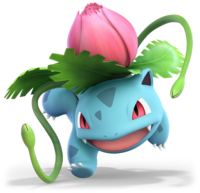
- “Ivysaur is the evolved form of Bulbasaur, one of the three Pokémon you can choose in the beginning. Compared to the other two Pokémon, you can reach the third form, Venusaur, quickest.”
- —Tips, Super Smash Bros. Ultimate
Ivysaur is a Grass/Poison-type Pokémon from the Pokémon series, appearing in Super Smash Bros. Brawl and Super Smash Bros. Ultimate as a playable character. In the Pokémon series, it is the evolutionary form of Bulbasaur and evolves into Venusaur.
Mario Artist: Paint Studio[edit]
Artwork of Ivysaur from Pokémon Red Version and Pokémon Green Version can be used as a stamp in Mario Artist: Paint Studio.
Super Smash Bros. Brawl[edit]
- SmashWiki article: Ivysaur (SSBB)
In the Super Smash Bros. series starting with Super Smash Bros. Brawl, Ivysaur appears as one of Pokémon Trainer's three Pokémon along with Squirtle and Charizard. Its standard special move is Bullet Seed, which involves it shooting seeds directly upward, its up special is Vine Whip, which has it attack with a vine that strikes upward, and its side special is Razor Leaf, which involves it throwing a grass projectile forward. Its down special is Pokémon Change, in which the Pokémon Trainer returns Ivysaur and sends out Charizard, or sends it out if Squirtle is the active Pokémon. For the group's collective Final Smash, Triple Finish, Ivysaur attacks with SolarBeam.
Ivysaur has a certain amount of stamina, which decreases as it remains on the battlefield and weakens its attacking power. Ivysaur also has an extended grab in the form of two vines, but unlike other characters it does not function as a tether recovery; this is instead given to Vine Whip. In addition, Ivysaur, like in the Pokémon games, takes less damage from water attacks but takes more from fire attacks.
Ivysaur is found during the Subspace Emissary part of the game as a trophy sitting inside a cave before Pokémon Trainer battles Charizard. Pokémon Trainer throws a Poké Ball at it and it is caught. After that Ivysaur can be used during the campaign.
Ivysaur is voiced by Craig Blair, who previously voiced it in the Generation I-V Pokémon anime.
Gallery[edit]
Super Smash Bros. for Nintendo 3DS / Wii U[edit]
The concept of switching between Pokémon is omitted from Super Smash Bros. for Nintendo 3DS / Wii U, causing Charizard to return as a standalone fighter, while Pokémon Trainer, Squirtle, and Ivysaur are not playable. Ivysaur, does however, appear as a trophy alongside Squirtle and Pokémon Trainer.
Super Smash Bros. Ultimate[edit]
- SmashWiki article: Ivysaur (SSBU)
Ivysaur reappears in Super Smash Bros. Ultimate as a playable character, alongside Pokémon Trainer and Squirtle. Ivysaur's design is updated to reflect its current appearance, while it is now voiced by Justin Alsemi, who has voiced it since Pokémon X and Y. Ivysaur's standard attack has a finisher in the form of a double vine slap, while its down tilt now only hits once. Additionally, some of its attacks have more range.
Ivysaur benefits from the game's universal changes: its mobility is faster; its aerial attacks have less landing lag; its short hop timing is reduced; it can directionally air dodge; and it can use any grounded attack out of a run, and any of its aerials on ladders. Ivysaur also benefits from Pokémon Change becoming faster, as it can easily switch to Charizard when needed. Lastly, some of its attacks also deal more knockback, have their damage rebalanced, or have less startup and ending lag. Ivysaur also benefits greatly from the removal of Pokémon Trainer's stamina and type effectiveness mechanics: the former allows Ivysaur to battle tirelessly, only switching to Squirtle or Charizard by will; the latter abolished Ivysaur's vulnerability to Fire-type attacks (e.g., Mario's forward smash), while also removing its resistance to Water-type attacks (e.g., Corrin's Dragon Fang Shot).
Names in other languages[edit]
| Language | Name | Meaning | Notes |
|---|---|---|---|
| Japanese | フシギソウ[?] Fushigisō |
From「不思議」(fushigi, mysterious) and「草」(sō, grass); also a pun on「不思議そう」(fushigi sō, a phrase meaning "it seems mysterious"); officially romanized as "Fushigisou" | |
| Chinese | 奇異草[?] Gēiyihchóu |
Literally "Unusual grass" | Hong Kong |
| 妙蛙草[?] Mìaowācăo |
Literally "Wonderful frog grass" | Mainland China, Taiwan | |
| French | Herbizarre[?] | Pun on "herbe" (grass) and "bizarre" | |
| German | Bisaknosp[?] | From "bisamratte" (muskrat) and "knospe" (bulb) | |
| Korean | 이상해풀[?] Isanghaepul |
Pun on "이상하다" (isanghada, strange) and "풀" (pul, grass) | |
| Portuguese (Brazil) | Ivyssauro[?] | A pun on the English name; ssauro come from "dinossauro" (dinosaur) | |
| Russian | Айвизавр[?] Ayvizavr |
Ivysaur | |
| Spanish | Ivysaur[?] | - |
Charizard[edit]
- Bulbapedia article: Charizard (Super Smash Bros.)
- SmashWiki article: Charizard
- This section is about the fire Pokémon featured in the Super Smash Bros. series, who is known as Lizardon in Japan. For the boss from Wario's Woods, see Lizardon.
- “Charizard, the Flame Pokémon, graced the package cover of Pokémon Red. Its fiery breath can melt anything, but it never turns its flame on an opponent weaker than itself.”
- —Tips, Super Smash Bros. Ultimate
Charizard is a Fire/Flying-type Pokémon resembling a winged European dragon. Its name is a combination of the words char, meaning burnt, and lizard. In the Pokémon series, it evolves from Charmeleon, which evolves from Charmander, and is one of the three fully-evolved starter Pokémon of the Kanto region. In Pokémon X and Pokémon Y, Charizard gained the ability to Mega Evolve into Mega Charizard X or Mega Charizard Y, the former of which appears as its Final Smash in Super Smash Bros. for Nintendo 3DS and Super Smash Bros. for Wii U. Charizard appears in Super Smash Bros. and Super Smash Bros. Melee as a Poké Ball Pokémon, and in Super Smash Bros. Brawl, Super Smash Bros. for Nintendo 3DS / Wii U, and Super Smash Bros. Ultimate as a playable character. When playable, its fighting style is similar to Bowser's, as a slow, powerful, heavy reptile with some fast movement options and the ability to breathe fire.
Super Smash Bros. series[edit]
Super Smash Bros.[edit]
Charizard appears in Super Smash Bros. as a Poké Ball Pokémon. When summoned, it turns from side to side, using Flamethrower to attack opponents.
Super Smash Bros. Melee[edit]
In Super Smash Bros. Melee Charizard once again appears as a Poké Ball Pokémon, retaining its attack and pattern from the original game, but this time using a 3D model ported from the Nintendo 64 Pokémon Stadium games instead of a 2D sprite, like all other Poké Ball Pokémon.
Super Smash Bros. Brawl[edit]
- SmashWiki article: Charizard (SSBB)
Charizard appears as one of the Pokémon used by the Pokémon Trainer (alongside Squirtle and Ivysaur), who remains in the background of a stage while Charizard fights. Charizard is the heaviest of the three Pokémon, but is also the strongest and the fastest, though it walks the slowest. It is also capable of gliding, one of three characters in the entire game with this ability. Like in the Pokémon games Charizard is also affected by an emulation of the series' type effectiveness; it takes more damage from water attacks but less from grass attacks. Charizard also has a limited stamina, which decreases as it is on the field but replenishes while it is not, but its attacks are weaker as its stamina decreases.
Charizard's standard special move is Flamethrower, which involves Charizard breathing a continuous stream of fire. Its side special move is Rock Smash, which has it break a rock with its head to damage opponents, and its up special is Fly, which has Charizard fly directly up into the air. When its down special Pokémon Change is used, Charizard is switched out with Squirtle, and is switched in when used as Ivysaur. Its Final Smash, shared amongst all three Pokémon, is Triple Finish, in which Charizard performs Fire Blast.
The Subspace Emissary[edit]
In the Subspace Emissary, Charizard is the last Pokémon that the Pokémon Trainer collects. Lucas and the trainer first see Charizard flying into a mountain, and Pokémon Trainer points out to Lucas that it is the third Pokémon he must collect. After traveling through the mountain, Pokémon Trainer and Lucas find Charizard, who attacks them. The two battle the large Pokémon, which is turned into a trophy upon its defeat. The trainer collects the trophy, and Charizard joins the party.
Gallery[edit]
Super Smash Bros. for Nintendo 3DS / Wii U[edit]
- SmashWiki article: Charizard (SSB4)
- “Charizard Fires it Up!”
- —Introduction, Super Smash Bros. Direct
Charizard returns as a playable character in Super Smash Bros. for Nintendo 3DS and Super Smash Bros. for Wii U. However, in both games, it is a standalone fighter, rather than being one of the Pokémon Trainer's Pokémon, due to the removing of in-battle transformation moves. As such, Rock Smash takes the place of Pokémon Change as its down special move, while its new side special move is Flare Blitz, which involves Charizard flying directly forward, covered in fire which also damages itself. Charizard's new Final Smash is Mega Evolution, which involves it Mega Evolving into its Mega Charizard X form[4]. In addition, the glide and type effectiveness mechanics have also been removed.
Like all the other playable Pokémon, Charizard can be equipped with the X Attack, X Defense, and X Speed equipment. Additionally, Charizard can use the Fake Nails equipment, making it the only fighter in the game who can use three different attack equipment types.
Gallery[edit]
Super Smash Bros. Ultimate[edit]
- SmashWiki article: Charizard (SSBU)
Charizard appears, along with Squirtle and Ivysaur, as part of the Pokémon Trainer's team in Super Smash Bros. Ultimate. Its moveset is similar to that seen in Super Smash Bros. for Nintendo 3DS / Wii U, with Rock Smash being replaced by Pokémon Change. Furthermore, its stamina mechanics are removed, allowing it to be used for the whole fight with no penalty. Just like in Super Smash Bros. Brawl, its final Smash is Triple Finish and no longer has it Mega Evolving into its Mega Charizard X form. Its type effectiveness mechanic is also abolished, which removes Charizard's vulnerability to Water-type attacks (e.g., those that Squirtle uses), but, in exchange, eliminates its resistance to Grass-type attacks (e.g., those that Ivysaur uses).
Charizard benefits from the game's universal changes: its overall mobility is faster (in spite of having a slightly slower walking speed); its aerials have less landing lag; its short hop timing is shortened; it can directionally air dodge; and it can use any grounded attack out of a run and any aerial attack while on ladders. Charizard's overall damage output and its attacks' knockback are both increased. In a similar vein to fellow veteran Sonic the Hedgehog and newcomers Inkling and Incineroar, Charizard takes minor damage from swimming in water; this is due to it both being unable to swim its home games and being weak to Water-type Pokémon in said games.
[edit]
Mario Artist: Paint Studio[edit]
Artwork of Charizard from Pokémon Red Version and Pokémon Green Version can be used as a stamp in Mario Artist: Paint Studio.
Super Mario Maker[edit]
Charizard appears as an unlockable costume in Super Mario Maker. It can be unlocked by scanning the Charizard amiibo onto the GamePad, or at random by clearing the 100 Mario Challenge on Normal or a more difficult setting. The costume turns Mario into a sprite of Charizard based on the species' appearance in the Nintendo DS Pokémon games. While Mario's appearance changes with the costume, like with the other Pokémon costumes, the sound effects remain the default Super Mario Bros. sounds.
Charmander, Charizard’s first stage form, appears as a costume as well. It is unlocked by completing the I Choose You! Event Course after picking the Charmander path. Unlike the fully-evolved Charizard, Charmander uses Pokémon sound effects.
Gallery[edit]
Names in other languages[edit]
| Language | Name | Meaning | Notes |
|---|---|---|---|
| Japanese | リザードン[?] Rizādon |
A portmanteau of "lizard" and "-odon" (meaning "tooth" in Ancient Greek, used as a common suffix for dinosaur names); officially romanized as Lizardon.[5] Considering the official romanization, it can possibly be a portmanteau of "lizard" and "dragon" as well, where the term used specifically refers to Western dragons | |
| Chinese | 喷火龙 (Simplified) 噴火龍 (Traditional)[?] Pēnhuǒlóng (Mandarin) Pānfólùhng (Cantonese) |
Fire-breathing Dragon | |
| French | Dracaufeu[?] | A portmanteau of "draco" (Latin for "dragon") and "feu" (fire) | |
| German | Glurak[?] | A portmanteau of "glut" (ember) and "drache" (dragon); also "-rak" comes from "raket" (rocket) | |
| Italian | Charizard[?] | - | |
| Korean | 리자몽[?] Rijamong |
Comes from "lizard" and "monster"; as well as the Korean words "룡" (ryong) or "용" (yong), which mean "dragon" | |
| Russian | Чаризард[?] Charizard |
- | |
| Spanish | Charizard[?] | - |
Notes[edit]
- Charizard's name in Japan, Lizardon, is the same name as a character in Wario's Woods. Interestingly, Wario's Woods preceded the release of Pokémon Red and Green in Japan by a little over two years.
Lucas[edit]
- “Lucas Comes Out of Nowhere!”
- —Introduction tagline, Super Smash Bros. for Nintendo 3DS and Super Smash Bros. for Wii U
Lucas is the protagonist of the Japan-only game Mother 3 from the EarthBound (Mother) series. In this game, he lived with his twin brother Claus and his parents Hinawa and Flint, in Tazmily Village located in the Nowhere Islands. However, tragedy soon strikes his family, as his mother is killed and his brother is lost, both of which set in motion Lucas' adventure to contend with the Pig Mask Army and its leader Porky.
Super Smash Bros. series[edit]
Super Smash Bros. Brawl[edit]
- SmashWiki article: Lucas (SSBB)
Lucas appears in Super Smash Bros. Brawl as a playable character, one of the two representatives from the EarthBound (Mother) series. Lucas' special moveset is almost exactly like Ness' from the previous games, but with a few minor tweaks. His neutral special is PK Freeze, which sends up a snowflake-shaped blast of PSI energy that freezes opponents caught in its blast radius when Lucas sets it off. His side special is PK Fire, which sends out a lightning bolt-shaped blast of PSI energy directly forward that explodes when it hits. His down special is PSI Magnet, which sets up a barrier of PSI energy in front of himself that absorbs projectiles to restore damage and attack when the barrier is dropped. His up special is PK Thunder, which discharges a streaming, electric blast of PSI energy that can attack opponents and/or propel Lucas. His Final Smash, also shared with Ness, is PK Starstorm, which sends groups of shooting stars raining down on the stage in an inward direction, damaging anybody hit by them, although they deal slightly less damage compared to Ness's PK Starstorm. Lucas does not actually learn any of his special moves in Mother 3; rather, they are all learned by his party member Kumatora.
However, almost all of Lucas' normal moves and smash attacks are completely different. The only exception is his forward smash attack, which operates similarly to Ness' baseball bat, albeit with Lucas wielding a stick instead. In addition, Lucas' grab is the Rope Snake, a weapon used by his party member Duster, which also acts as a tether recovery. One of Lucas's alternate costumes resembles his brother Claus. Lucas's home stage is New Pork City.
Lucas was originally meant to replace Ness in Super Smash Bros. Melee.[6] However, this was averted due to the delay and cancellation of Mother 3 for the Nintendo 64, then tentatively known in North America as EarthBound 64. Nonetheless, Mother 3 was later rescheduled and redeveloped for the Game Boy Advance in 2003 and was released in 2006, though only in Japan.
Lucas is voiced by Lani Minella, who also voices Pit.
Role in the The Subspace Emissary[edit]
In The Subspace Emissary, Lucas is shown as a weak, shy and timid figure, almost identically to how he appeared in the beginning of Mother 3.
Lucas first appears alone in The Ruined Zoo. He is attacked by the Porky Statue, but Ness arrives to save him. They proceed to fight Porky, but then Wario arrives with his Dark Cannon and attempts to hit Ness with it. Ness dodges his attacks, so Wario tries to attack Lucas instead. Lucas doesn't move out of the way, so Ness ends up taking the hit himself. Lucas, scared, runs away and meets the Pokémon Trainer, and they join to fight the Subspace Army, as Lucas cannot forget what Wario had done to Ness.
Outside the Ruins, the Pokémon Trainer decides to capture a Charizard that flew by. Before entering them, however, they are ambushed by Wario. They defeat him, but Lucas becomes disappointed that Wario does not have Ness with him anymore. After capturing Charizard and an Ivysaur inside the Ruins, Lucas and the Pokémon Trainer reach The Ruined Hall, where they are attacked by Galleom. After defeating him, Galleom takes them and starts flying into the air, with a Subspace Bomb in his head about to go off. Lucas frees himself and the Pokémon Trainer, and they are then saved by Meta Knight, whose team they then join.
At The Glacial Peak, Meta Knight leaves them, but they are then joined by the Ice Climbers as the Subspace Army is sent out to attack them. Mario, Link, Yoshi, Kirby and Pit then appear and defeated the enemies. Soon, the other remaining heroes show up and they enter Subspace together. Unfortunately, Lucas and the others were defeated by Tabuu. But then Lucas is saved by King Dedede, who had revived Ness and Luigi with badges. All of the revived heroes then fight and defeat Tabuu.
Gallery[edit]
Super Smash Bros. for Nintendo 3DS / Super Smash Bros. for Wii U[edit]
- SmashWiki article: Lucas (SSB4)
Lucas was initially absent from the roster, but later on released as the second downloadable playable character after Mewtwo in Super Smash Bros. for Nintendo 3DS and Super Smash Bros. for Wii U, on June 14, 2015.[7] Visually, Lucas' moveset is almost unchanged from the previous game, though his Final Smash, PK Starstorm, has been altered to be similar to Ness' version. Additionally, Lucas has three new alternate costumes, which feature sprites of the Masked Man, Boney, and a baby Drago on his shirt. Lucas' design is changed: he loses the blush on his cheeks, his eyes lose their bluish hue, and he is taller and sleeker overall. Lucas' mobility is improved in this installment, while his attacks can better link into each other. On the downside, however, many of his attacks either deal less damage and knockback or have less range.
Gallery[edit]
Super Smash Bros. Ultimate[edit]
- SmashWiki article: Lucas (SSBU)
Lucas appears as a playable fighter in Super Smash Bros. Ultimate. His moveset is mostly unchanged, but Lucas is now assisted by Kumatora and Boney for PK Starstorm. Lucas receives improvements to his mobility, while his grounded and aerial attacks come out quicker. Lucas's damage output receives a mix of positive and negative alterations (such as up aerial dealing 11% instead of 13%, while his down throw deals 11% instead of 6.5%). Several of Lucas's attacks receive names: his up smash is PK Smash Geyser, his down smash is PK Blow, his back aerial is PK Meteor Kick, and his down aerial is PK Foot Stomp.
Classic Mode route[edit]
| Magic, Sacred Powers, and PSI! | ||||
|---|---|---|---|---|
| Round | Opponent(s) | Stage | Song | |
| 1 | Ness | Magicant | Magicant | |
| 2 | Robin (male), Robin (female) | Arena Ferox | Conquest (Ablaze) | |
| 3 | Rosalina | Mario Galaxy | Gusty Garden Galaxy | |
| 4 | Giant Palutena | Palutena's Temple (Ω) | Underworld | |
| 5 | Bayonetta | Umbra Clock Tower | Tomorrow Is Mine (Bayonetta 2 Theme) (Instrumental) | |
| 6 | Mewtwo | Kalos Pokémon League | Battle! (Team Galactic) | |
| Final | Master Hand, Crazy Hand (intensity 7.0 or higher) | Final Destination | Master Hand Master Hand / Crazy Hand (intensity 7.0 or higher) | |
[edit]
Super Mario Maker[edit]
In Super Mario Maker, Lucas appears as a Mystery Mushroom costume, which plays the sound effect from Mother 3 when an important item is obtained upon transforming into him. The costume can be randomly unlocked after completing the 100 Mario Challenge on Expert or harder, or unlocked by scanning the Lucas amiibo. Lucas is one of the two downloadable fighters from Super Smash Bros. for Nintendo 3DS and Super Smash Bros. for Wii U that appear as costumes in Super Mario Maker; the other being Mewtwo.
Quotes[edit]
- "PK Freeze!" - Super Smash Bros. Brawl
- "PK Fire!" - Super Smash Bros. Brawl
- "PK Thunder!" - Super Smash Bros. Brawl
- "PK Starstorm!" - Super Smash Bros. Brawl
- "Ow!" - Super Smash Bros. Brawl
- "Huh?" - Super Smash Bros. Brawl
Audio samples[edit]
| File info |
Names in other languages[edit]
| Language | Name | Meaning | Notes |
|---|---|---|---|
| Japanese | リュカ[?] Ryuka |
From the French pronunciation of the name, [ly.kɑ] | Derived from the novel Le Grand Cahier by Hungarian writer Ágota Kristóf |
| Chinese | 琉加[?] Liújiā |
Lucas | |
| Korean | 류카[?] Ryuka |
Lucas | |
| Russian | Лукас[?] Lukas |
Lucas | |
| Spanish | Lucas[?] | - |
King Dedede[edit]
- Wikirby article: King Dedede
- SmashWiki article: King Dedede
- “King Dedede can float after taking in a big gulp of air. This move is the result of lots of hard work and training so he could put up a fight against Kirby after previously losing to him.”
- —Tips, Super Smash Bros. Ultimate
King Dedede is a large penguin-like creature,[8] the self-proclaimed king of Dream Land, and the rival of Kirby in the Kirby series. In his home series, he has acted as both an ally and enemy to Kirby.
Super Smash Bros. series[edit]
Super Smash Bros.[edit]
King Dedede makes a minor appearance in Super Smash Bros., as a background element that can be seen flying by on the Dream Land stage.
According to the website, King Dedede was originally planned to be a playable character, but he was cut due to time constraints.[9]
Super Smash Bros. Melee[edit]
In Super Smash Bros. Melee, King Dedede makes an appearance as a trophy. He is also still on the Dream Land stage, which returns from the original Super Smash Bros.
Super Smash Bros. Brawl[edit]
- SmashWiki article: King Dedede (SSBB)
King Dedede makes his playable debut in the Super Smash Bros. series in Super Smash Bros. Brawl. In the game, he is voiced by Masahiro Sakurai, his original creator and the director of the Super Smash Bros. series, who also voiced him in Kirby 64: The Crystal Shards. King Dedede is one of the heaviest characters, making him slower, but similar to Kirby, he has multiple mid-air jumps, and has the fastest falling speed of any character. Dedede's hammer gives his moves range and power, but many of his attacks are slow to execute to compensate.
Dedede's standard special move is Inhale, which works similarly to Kirby's move, but Dedede cannot copy opponents, and instead is only able to carry them and spit them back out as a projectile. His side special move is Waddle Dee Toss, in which he throws a Waddle Dee (occasionally a Waddle Doo or rarely a Gordo) at opponents. His up special move is Super Dedede Jump, in which Dedede leaps into the air and slams back toward the ground. His down special move is Jet Hammer, in which Dedede charges a hammer swing powered by a jet engine. Dedede's Final Smash is Waddle Dee Army, which summons Waddle Dees, Waddle Doos and Gordos to attack.
Aside from King Dedede's standard and up specials, his dash attack and forward smash originate from the Kirby games, with the former being his signature trip, while the latter is an attack he commonly uses against Kirby.
The Subspace Emissary[edit]
In the Subspace Emissary, King Dedede learns of Tabuu's motives, and about his Off Waves, and worries that if all the fighters of the World of Trophies are all turned into trophies, then there will be no one to change them back. Therefore, he develops special brooches that are set to turn trophies back into fighters after a specific amount of time. It is also revealed through the Smash Bros. DOJO!! that King Dedede engages Meta Knight in combat as the Subspace Army takes his Halberd, though this scene was cut from the final version of Super Smash Bros. Brawl.[10]
He is first seen attacking Luigi with his mallet and turning him into a trophy. He then hides and leaves the trophy out in the open as bait. Wario comes along with the Princess (Peach or Zelda, depending on who Kirby rescued) and Ness and sees Luigi's trophy. Wario takes it, but King Dedede's Waddle Dees come and attack Wario. Wario lets go of the Luigi trophy, which King Dedede takes. After that, he steals Wario's vehicle and drives off with the Princess trophy and Ness trophy. He later attempts to take either the Mario and Pit trophies or the Link and Yoshi trophies, until Kirby shows up and frees them. All five character chase down King Dedede.
In his castle, he puts one of his brooches on all the trophies he collected, giving the one he was keeping for himself to the Princess. However, Bowser starts attacking them, turning Dedede into a trophy and after a battle, Bowser escapes with the princess trophy (who dropped the badge King Dedede put on her) and Mario, Link, Pit, Yoshi, and Kirby run away leaving the King Dedede, Luigi, and Ness trophies behind. Later, King Dedede's castle is blown up by the Subspace Bomb and the Luigi, Ness and King Dedede trophies are pulled into Subspace. Meanwhile, Kirby finds the other Dedede badge that the princess dropped and Inhales it.
After Tabuu turns everyone into trophies, the brooches activate, bringing Luigi and Ness back to life, who in turn revive King Dedede as well. King Dedede then helps Ness and Luigi save everyone. When King Dedede brings Bowser back to life, Bowser attacks. However King Dedede defeats him, turning him into a trophy. Dedede then revives Bowser and before he can attack again, flicks him on the nose, then points over toward the staircase to the Great Maze.
After Kirby arrives with several more fighters, King Dedede directs them to the Great Maze. They explore the maze, defeating previously defeated bosses and battling clones of themselves. After defeating all of these, they head in to Tabuu's chamber for the final battle. Tabuu attempts to turn all the fighters back into trophies, but is ambushed by Sonic, weakening him and allowing the fighters to defeat him. Tabuu disappears and the World of Trophies is restored.
Gallery[edit]
Super Smash Bros. for Nintendo 3DS / Super Smash Bros. for Wii U[edit]
- SmashWiki article: King Dedede (SSB4)
King Dedede returns as a playable character in Super Smash Bros. for Nintendo 3DS and Super Smash Bros. for Wii U. While Masahiro Sakurai reprises King Dedede's role, he is given a more distorted voice. Several of his moves have been changed from the previous game; most of his aerial attacks are new, his side special has been changed to Gordo Throw, in which Dedede hammers a Gordo to attack opponents, and his Final Smash has been changed to Dedede Burst, which involves Dedede drawing in opponents with his suction breath before hammering them and ending with a bomb exploding on them. While most of his attributes remain relatively unchanged, he no longer has the fastest falling speed; King Dedede's air speed is slower, though other aspects of his mobility are improved. Similarly to Meta Knight, King Dedede also has his overall damage output toned down.
Dedede also once again appears flying in the background of the Dream Land (64) stage that returns as downloadable content, though only when he is not part of the battle.
Gallery[edit]
Super Smash Bros. Ultimate[edit]
- SmashWiki article: King Dedede (SSBU)
King Dedede returns as a playable character in Super Smash Bros. Ultimate where he is unlockable for the first time in the series. He has a new Final Smash, called the Dede-Rush, in which he traps opponents in a caged arena and fires missiles at them before finishing them off with his hammer as Masked Dedede, launching them away. This makes him one of the few fighters that have appeared since Super Smash Bros. Brawl to have a different Final Smash in each appearance (along with R.O.B., Pit, and Zero Suit Samus). King Dedede's back aerial is now a horizontal hammer swing, which has much greater range than his previous one. Aesthetically, Jet Hammer now burns with blue fire instead of orange. King Dedede's mobility is improved in all aspects, while a majority of his attacks are faster, deal more damage or knockback, or have larger hitboxes. His down tilt is Rolling, while his dash attack is Belly Flop. King Dedede can now inhale his own Gordos and other projectiles and spit them back out.
Like in Super Smash Bros. for Nintendo 3DS and Super Smash Bros. for Wii U, King Dedede also appears flying in the background of Dream Land (64), though only when he is not part of the battle.
King Dedede briefly appears in King K. Rool's debut trailer, where he pranks Donkey and Diddy Kong by wearing a King K. Rool disguise, and then proceeding to laugh hysterically at the joke he played on them before being knocked out by the actual King K. Rool.
In the Chinese version, King Dedede is the only character whose name is announced differently between the Simplified and Traditional Chinese versions: The former uses "King Dedede!" from the English version, while the latter uses "Dedede!" from the Japanese version.
Classic Mode route[edit]
King Dedede's route pits him against fighters associated with royalty.
| Royal Rumble | ||||
|---|---|---|---|---|
| Round | Opponent(s) | Stage | Song | |
| 1 | King K. Rool | Pirate Ship | Gang-Plank Galleon | |
| 2 | Marth, Roy | Castle Siege | Fire Emblem Theme | |
| 3 | Zelda | Hyrule Castle | Overworld Theme - The Legend of Zelda (64) | |
| 4 | Peach, Daisy | Princess Peach's Castle | Underwater Theme - Super Mario Bros. | |
| 5 | Bowser, Bowser Jr. | Find Mii (Battlefield) | King Bowser - Super Mario Bros. 3 | |
| 6 | Ganondorf | Bridge of Eldin | Calamity Ganon Battle - Second Form | |
| Final | Master Hand, Crazy Hand (intensity 7.0 or higher) | Final Destination | Master Hand Master Hand / Crazy Hand (intensity 7.0 or higher) | |
Gallery[edit]
[edit]
Mario Kirby Meisaku Video[edit]
King Dedede, alongside his rival Kirby, appeared alongside Mario in the obscure educational video Mario Kirby Meisaku Video; however, this video was merely a compilation of their non-intertwining adventures. In Kirby's Mario Kirby Meisaku Video segment, King Dedede acted as the main antagonist, where it was believed that he had kidnapped the mother of a stray puppy that Kirby befriended. In actuality, King Dedede discovered the dog to have been injured and attempted to nurse her back to health at his castle.
Super Mario Maker[edit]
King Dedede also appears in Super Mario Maker as a Mystery Mushroom costume, based on his appearance in Kirby's Adventure.
Gallery[edit]
Japanese commercial for the New Famicom, Wario's Woods, and The Legend of Zelda 1
Audio samples[edit]
| File info |
Names in other languages[edit]
| Language | Name | Meaning | Notes |
|---|---|---|---|
| Japanese | デデデ大王[?] Dedede daiō |
Great King Dedede | |
| Chinese | 迪迪迪大王[?] Dídídí Dàwáng |
King Dedede | |
| 帝帝帝大王[?] Dìdìdì Dàwáng |
Super Smash Bros. Ultimate | ||
| Dutch | Koning Dedede[?] | King Dedede | |
| French (Canada) | Roi Dadidou[?] | King Dadidou | |
| French (Europe) | Roi DaDiDou[?] | King DaDiDou | |
| German | König Nickerchen[?] | King Nap | until Kirby: Nightmare in Dreamland |
| King Dedede[?] | - | after Kirby: Nightmare in Dreamland | |
| König Dedede[?] | King Dedede | since Super Smash Bros. Brawl | |
| Italian | King Dedede[?] | - | |
| Korean | 디디디 대왕[?] Dididi Daewang |
King Dedede | |
| Portuguese | Rei Dedede[?] | King Dedede | |
| Russian | Король Дидиди[?] Korol' Dididi |
King Dedede | |
| Spanish | Rey Dedede[?] | King Dedede |
Olimar[edit]
- “The S.S. Dolphin runs into trouble during a space vacation, causing it to crash-land on an unexplored planet. Olimar tries to repair the ship using the help of the Pikmin he meets there.”
- —Tips, Super Smash Bros. Ultimate
Captain Olimar (or simply Olimar) is the main protagonist of the Pikmin franchise, created by Shigeru Miyamoto. Olimar is actually named after Mario himself (Olimar is an anagram of Mario, with an L added; his Japanese name, Orimā, (オリマー) which was romanized as Olimar, is a near perfect anagram of "Mario"). He has crossed over with the Super Mario franchise primarily through the Super Smash Bros. series, but also through Nintendo Land as well, where Pikmin gets its own attraction, titled "Pikmin Adventure." Most of his other appearances involve cameos via amiibo.
Olimar had to be scaled up drastically, even more so than Kirby, for his appearance in the Super Smash Bros. series, as according to the Pikmin game manual, he is only about an inch tall. Olimar does not have any voice effects (unless players count his whistles as a voice effect) in Super Smash Bros. Brawl, making him the only playable character in the game without a star KO sound effect (although he would later share this trait with other characters in future installments). However, in Pikmin 2, Pikmin 3, and Super Mario Maker, he is voiced by Kazumi Totaka.
In Super Smash Bros. games beginning with Super Smash Bros. for Nintendo 3DS onward, Alph, one of the protagonists of Pikmin 3, appears as an alternate costume of Olimar. His attacks and statistics are identical to Olimar's with any and all changes merely being cosmetic. As with other alternative costumes, the games do not acknowledge him as a separate character from Olimar in battle records and miscellaneous aspects, such as Classic Mode. The exception to this is the announcer, crowd, and character selection, all of which say and/or display his own name. He shares this trait with the Koopalings (the alternate costumes of Bowser Jr.) who are also named, but not acknowledged as separate characters.
Luigi's Mansion[edit]
A trailer for the first Pikmin game, which includes Olimar, appears in Luigi's Mansion's option screen. As the release of Luigi's Mansion predates that of Pikmin, this marks Olimar's overall first appearance in a video game.
Mario & Luigi: Superstar Saga[edit]
Olimar was planned to make an appearance in Mario & Luigi: Superstar Saga as one of the characters that appears when Mario and Luigi create new brews in Starbeans Cafe. In this appearance, his dialogue was written in the type of text box that appears whenever Mario or Luigi get certain items, as though written in a log book like in the actual Pikmin games. He also names Mario "Marlio" (a complete anagram of "Olimar") and mistakes Luigi for a dangerous beast.[11] However, Professor E. Gadd replaced all of the other characters in the final version of the game in order to give E. Gadd a larger role.
Super Smash Bros. series[edit]
Super Smash Bros. Melee[edit]
In Super Smash Bros. Melee, Olimar appears in the form of a trophy, which is unlocked if there is a Memory Card with saved game data for Pikmin inserted.
Super Smash Bros. Brawl[edit]
- SmashWiki article: Olimar (SSBB)
Captain Olimar's playable debut in the Super Smash Bros. series is Super Smash Bros. Brawl, as one of the game's default fighters. Olimar is one of the smaller and lighter characters in the game. He fights with the help of up to six Pikmin, which follow him and are required in order to perform most of his attacks. Each type of Pikmin (red, blue, yellow, purple, and white) has its own attributes, which produce different effects for Olimar's attacks.
Olimar's standard special is Pikmin Pluck, which allows him to pull up more Pikmin (if he has less than six) from the ground. His side special is Pikmin Throw, in which Olimar tosses one of his Pikmin at his opponents. His down special is Pikmin Order, which allows him to call his Pikmin back to his side and grants him super armor as a defensive option. His up special is Pikmin Chain, in which Olimar tosses all of his Pikmin in a chain as a tether recovery. His Final Smash is End of Day, in which he takes off while Bulborbs come on the stage and start attacking the players, similarly to the "end of day" sequence from the Pikmin games. His "home" stage is the Distant Planet.
One of Olimar's costumes makes him look very similar to his sidekick, Louie.
The Subspace Emissary[edit]
Captain Olimar's Pikmin are attacking a huge R.O.B. However, the R.O.B. spins around and all the Pikmin that are latched onto him are shaken off and perish. Captain Olimar starts shivering in fear of the robot. A red Pikmin walks up to Olimar and taps him on the side. Olimar turns around and the red Pikmin points at the Blue Falcon that is speeding through the forest.
Captain Falcon jumps out of the Blue Falcon and then Falcon Punches the R.O.B., which defeats the R.O.B. instantly. Captain Falcon lands back on the ground while doing a slide similar to the Falcon Kick. However, while he is sliding on the ground, he accidentally kills the Pikmin who are in the way. Olimar and the Captain then team up to fight the Subspace Army.
Upon reaching the edge of the Isle of the Ancients, they witness Diddy Kong attacking Primids in order to rescue his pal Donkey Kong. Falcon and a reluctant Olimar then decide to join forces with the Kongs, and upon reaching them, the Primids return with backup. Donkey Kong, Diddy Kong, Captain Falcon, and Olimar manage to fight them off before they see off Falco, who had helped Diddy in bringing him to the ship that Donkey was held on.
The ship takes Olimar and his crew inside the Subspace Bomb Factory. They eventually find the Ancient Minister, alongside Pikachu and Samus. Ganondorf suddenly appears via hologram and commands the R.O.B.s in the room to detonate the Subspace Bombs inside the factory so he can create a large enough hole in space to fit a Subspace Gunship through. The Ancient Minister through desperation reveals himself to be the leader of the R.O.B.s and helps the other heroes defeat the Subspace enemies that Ganondorf dispatched. Olimar, with R.O.B. and the rest of the heroes, escapes from the island before it is dragged into Subspace. All of the protagonists then unite to take down the Subspace Gunship and enter Subspace. Olimar and the others are subsequently turned into trophies by Tabuu however.
Luckily, King Dedede had created badges that revive trophies beforehand, with Ness and Luigi eventually coming to their senses amidst the rubble of Dedede's Castle, which was destroyed by Bowser earlier on. The two eventually decide to revive Dedede and journey into Subspace to revive as many heroes as possible. Olimar is one of the trophies that may be revived by them when they enter Subspace. However it is optional for the player to revive him.
Gallery[edit]
Super Smash Bros. for Nintendo 3DS / Super Smash Bros. for Wii U[edit]
- SmashWiki article: Olimar (SSB4)
Olimar appears as a default playable character in Super Smash Bros. for Nintendo 3DS and Super Smash Bros. for Wii U. His appearance has been altered from the previous game, adding a whistle into his helmet like in Pikmin 3. Instead of having six Pikmin like in Super Smash Bros. Brawl, Olimar can now only pluck three Pikmin at a time, and in a certain order (being red, yellow, blue, white, and purple). His up special move has also been changed to Winged Pikmin, in which a pair of Winged Pikmin fly Olimar through the air for a short time; however, the more active Pikmin he has, the heavier he is when using this move. Four of Olimar's alternate costumes replace him with Alph from Pikmin 3, who acts as a separate character to Olimar, while still taking up the same slot as him. Olimar's home stage in the Wii U version of the game is Garden of Hope. For Equipment, Olimar can use the Pikmin equipment (usable only by him) to increase attack, the Space Suit (also available only to him) for defense, and the Boots for speed.
According to Masahiro Sakurai, the developers barely got Captain Olimar working in Super Smash Bros. for Nintendo 3DS,[12] hence why the Pikmin count is reduced to three while the Pikmin are rendered as sprites.[13] Rock Pikmin were originally intended to be part of Olimar's moveset, but the idea was put in hold due to the lack of time.[14] They would have been heavy, with short reach, but high attack power, akin to a stronger version of Purple Pikmin. Alph had even been considered to be a separate clone character until it was decided to make him an alternate costume of Olimar.[15]
Gallery[edit]
Super Smash Bros. Ultimate[edit]
- SmashWiki article: Olimar (SSBU)
Olimar returns as an unlockable playable fighter in Super Smash Bros. Ultimate. This time, after Olimar takes sufficient damage, his helmet becomes cracked, though this is merely cosmetic as it becomes fixed soon afterwards. The alternate costumes that switch him out for Alph return.
Captain Olimar's fighter spirit uses his artwork from Hey Pikmin!. Alph's fighter spirit uses his artwork from Pikmin 3.
Classic Mode route[edit]
| Planetary Explorer | ||||
|---|---|---|---|---|
| Round | Opponent(s) | Rule | Stage | Song |
| 1 | Mario, Rosalina | Mario Galaxy | Super Mario Galaxy | |
| 2 | Wolf | Lylat Cruise | Star Wolf's Theme / Sector Z (for 3DS / Wii U) | |
| 3 | Kirby, King Dedede | Free-for-All | Dream Land | Planet Popstar |
| 4 | Zero Suit Samus | Brinstar | Brinstar (Melee) | |
| 5 | Fox, Falco | Corneria | Corneria - Star Fox | |
| 6 | Alph / Olimar* | Distant Planet | Garden of Hope | |
| Final | Master Hand, Crazy Hand (intensity 7.0 or higher) | Final Destination | Master Hand Master Hand / Crazy Hand (intensity 7.0 or higher) | |
* - Olimar is fought if the player is playing as Alph.
WarioWare: D.I.Y.[edit]
Olimar is seen in the WarioWare: D.I.Y. microgame Pikmin, exclusive to versions of the game outside Japan. The player controls Captain Olimar, who is holding a Red Pikmin in his hand and must toss it onto a small raft with nectar on it.
Nintendo Land[edit]
An attraction called Pikmin Adventure is featured in Nintendo Land. In this minigame, the player with the GamePad is dressed up as Olimar and uses Pikmin figurines to help him locate the lost spaceship.
Mario Kart 8 / Mario Kart 8 Deluxe[edit]
In Mario Kart 8 (as of the version 4.0 update) and Mario Kart 8 Deluxe, players can scan Olimar's amiibo into the game to unlock a racing suit for Miis based upon his appearance. Olimar himself can be seen on the Mii Racing Suits menu next to his respective Mii racing suit.
Yoshi's Woolly World / Poochy & Yoshi's Woolly World[edit]
An Olimar theme is one of the many unlockable amiibo designs for Yoshi in Yoshi's Woolly World and Poochy & Yoshi's Woolly World. By scanning an Olimar amiibo, players can unlock an Olimar-themed reskin for Yoshi.
Super Mario Maker[edit]
Olimar, alongside the majority of the Super Smash Bros. for 3DS and Super Smash Bros. for Wii U playable cast, cameos as one of the costumes Mario can obtain in Super Mario Maker via the Costume Mario power-up. Upon powering up, Olimar's voice from Pikmin 2 can be heard. If the player completes a level as Olimar, the "Course Clear" fanfare is replaced by the tune that plays after obtaining an important item in Pikmin 3. Pressing ![]() on the controller lets Olimar blow his whistle.
on the controller lets Olimar blow his whistle.
Gallery[edit]
Artwork[edit]
Sprites and models[edit]
Mario & Luigi: Superstar Saga (unused)
Screenshots[edit]
Quotes[edit]
- "...I detect a strange, yet pleasing aroma drifting through the atmosphere of this cafe. It would seem to require further investigation..." - Unused quote from Mario & Luigi: Superstar Saga
- "What is this? Before my eyes stands a strange life form. It resembles me slightly, so I shall dub it...Marlio! ...Further investigation indicates that the drink that this Marlio holds is the source of the aroma. I shall now partake of its flavor. Why! Its flavor is most satisfying! Finding that such a drink could be partook of in such a place is a tremendous discovery, indeed! This Marlio creature exhibits what seems to be a longing expression... Perhaps it will react if I present it with something... I have just noticed a strange, unsightly green creature standing next to the Marlio... It could be a dangerous life form. I feel I should attack it before it attacks me." - Unused quote from Mario & Luigi: Superstar Saga
Names in other languages[edit]
| Language | Name | Meaning | Notes |
|---|---|---|---|
| Japanese | オリマー[?] Orimā |
Olimar; also, an anagram of Mario's name | |
| Chinese (Simplified) | 奥利马[?] Àolìmǎ |
Olimar | |
| 欧力马[?] Ōulìmǎ |
Olimar; also, an anagram of Mario's name | Super Smash Bros. Ultimate | |
| Chinese (Traditional) | 奧利馬[?] Àolìmǎ |
Olimar | |
| 歐利瑪[?] Ōulìmǎ |
Olimar; also, an anagram of Mario's name | Super Smash Bros. Ultimate | |
| Korean | 올리마[?] Ollima |
Olimar | |
| Russian | Олимар[?] Olimar |
Olimar | |
| Spanish | Olimar[?] | - |
Alph[edit]
| Language | Name | Meaning | Notes |
|---|---|---|---|
| Japanese | アルフ[?] Arufu |
Alph; possibly from "alpha" | |
| Chinese (Simplified) | 阿尔福[?] Ā'ěrfú |
Alph | |
| Chinese (Traditional) | 阿爾福[?] Ā'ěrfú |
Alph | |
| Korean | 알프[?] Alpeu |
Alph | |
| Russian | Альф[?] Al'f |
Alph | |
| Spanish | Alph[?] | - |
Notes[edit]
- In the Super Smash Bros. series, Olimar's eyes never glow yellow if he has broken the Smash Ball, not even if he is attacked.
- According to design documents, at one point during development of Super Smash Bros. for Nintendo 3DS and Super Smash Bros. for Wii U, Alph was being considered as a fully separate playable character; he would have been a clone of Olimar, except with the addition of utilizing Rock Pikmin.[16]
- On his fighter page on the desktop version of the official English Super Smash Bros. Ultimate website, Olimar's name was originally misspelled as "Olimer." This mistake has since been corrected.
Lucario[edit]
- Bulbapedia article: Lucario (Super Smash Bros.)
- SmashWiki article: Lucario
- “Watch the power of Aura!”
- —Lucario, Super Smash Bros. Brawl
Lucario is a Fighting/Steel-type Pokémon from the Pokémon series. It originates from the movie Pokémon: Lucario and the Mystery of Mew before debuting in the games with Pokémon Diamond and Pokémon Pearl and is the evolved form of Riolu. In Pokémon X and Pokémon Y, Lucario gained the ability to Mega Evolve into Mega Lucario.
Super Smash Bros. series[edit]
Super Smash Bros. Brawl[edit]
- SmashWiki article: Lucario (SSBB)
Lucario appears as an unlockable playable character in Super Smash Bros. Brawl. It can be unlocked by playing 100 Brawl matches, completing every level of Target Smash with one character, or by having it join the party in The Subspace Emissary by clearing The Glacial Peak. Its voice clips in this game are provided by Bill Rogers in the English release, who voices Lucario for the television series, and Daisuke Namikawa in Japanese, who provided the voice of the Lucario in the movie Pokémon: Lucario and the Mystery of Mew and the Pokémon Diamond and Pearl seasons of the animated series.
Lucario's attacks and abilities mostly revolve around Aura, which increases in power the more damage Lucario takes (though this only applies to attacks that use its Aura). Its standard special move is Aura Sphere, in which Lucario charges and throws a ball of Aura energy. Its side special move is Force Palm, in which Lucario thrusts its hand forward to attack with a burst of energy. Its down special move is Double Team, in which Lucario counterattacks an opponent that attacks it. Its up special move is ExtremeSpeed, in which Lucario flies in the direction the player inputs. Its Final Smash is Aura Storm, in which Lucario leaps into the air and fires a beam down onto the stage.
The Subspace Emissary[edit]
Lucario is first encountered in The Subspace Emissary at the top of The Glacial Peak, where it is balanced on the peak when Meta Knight and the Ice Climbers arrive. Lucario and Meta Knight battle (the player able to control either character), and the loser is turned into a trophy. The winner revives the loser, and the two shake hands, now allies. However, in its battle with the Great Fox, the Halberd smashes the Great Fox into the mountain, allowing Lucario and Meta Knight to climb aboard the Halberd.
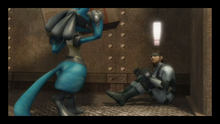
As the two are traveling through the Halberd, Lucario senses Snake's Aura from inside his cardboard box and exposes him. His cover blown, Snake and Meta Knight are about to fight, but Lucario stops them, sensing the Aura of some nearby Primids which they fight instead. As the three travel on they find a room where the trophies of Peach and Zelda are being held in cages. Shadow Bugs then appear and take the form of the princesses, which Lucario, Meta Knight and Snake battle. After the clones are defeated the actual Peach and Zelda are freed and left in the room while the group travels on. They arrive at the bridge, where they find multiple Mr. Game & Watches controlling the ship. Snake knocks them all onto the main deck, where they dissolve into Shadow Bugs and reform into Duon. Snake and Lucario leap down onto the deck, teaming up with Sheik, Peach, Fox, and Falco to fight. After it is defeated, Duon dissolves to reveal the actual Mr. Game & Watch's trophy, which Peach restores.
The Halberd lands in the desert, where most of the cast units. They all then fight against the Subspace Gunship and make it to Subspace. Inside, the team stand against Tabuu, but are all instantly turned into Trophies. However, they are all eventually restored and head to face Tabuu. After he is defeated, everyone returns to the real world, the Subspace portals all closed.
Gallery[edit]
Super Smash Bros. for Nintendo 3DS / Wii U[edit]
- SmashWiki article: Lucario (SSB4)
Lucario returns as a playable character in Super Smash Bros. for Nintendo 3DS and Super Smash Bros. for Wii U. In English, it is now voiced by Sean Schemmel, who voiced the Lucario in the English version of Lucario and the Mystery of Mew. It retains all of its special moves, as well as the Aura mechanic, which has been made more powerful and now affects all of its attacks. Its Final Smash is now Mega Evolution, in which Lucario temporarily Mega Evolves, increasing the power of its Aura to maximum.
Gallery[edit]
Super Smash Bros. Ultimate[edit]
- SmashWiki article: Lucario (SSBU)
Lucario returns as an unlockable playable character in Super Smash Bros. Ultimate. Its Final Smash has reverted to Aura Storm from Super Smash Bros. Brawl, although Lucario now Mega Evolves into Mega Lucario before performing the move. Like all other characters, Lucario's mobility is improved, having faster walking, dashing, and air speeds, as well as higher air acceleration, while its short hop timing is reduced. However, Lucario's Aura mechanic sees some adjustments, being less effective at low damage, yet more effective at high damage.
In the World of Light, Lucario, alongside Greninja, are present when the fighters oppose Galeem for the first time. Lucario attempts to resist Galeem's large laser attack with Double Team, but ultimately is consumed and used to create puppet fighters.
Classic Mode route[edit]
Lucario's Classic Mode route involving characters who possess a counterattack, like Lucario's own Double Team, for their special moveset.
| Counter Encounters | ||||
|---|---|---|---|---|
| Round | Opponent(s) | Rule | Stage | Song |
| 1 | Shulk, Little Mac | Gaur Plain | Time to Fight! - Xenoblade Chronicles | |
| 2 | Palutena, Bayonetta | Umbra Clock Tower | Red & Black | |
| 3 | Marth, Lucina | Coliseum | Story 5 Meeting | |
| 4 | Mii Swordfighter ×6 | Horde Battle | Spear Pillar | Battle! (Wild Pokémon) - Pokémon Diamond / Pokémon Pearl |
| 5 | Roy, Ike, Corrin | Castle Siege | The Devoted | |
| 6 | Greninja | Pokémon Stadium 2 | Battle! (Champion) - Pokémon X / Pokémon Y | |
| Final | Master Hand, Crazy Hand (intensity 7.0 or higher) | Final Destination | Master Hand Master Hand / Crazy Hand (intensity 7.0 or higher) | |
Super Mario Maker[edit]
Lucario appears as a Costume Mario costume in Super Mario Maker. It can be unlocked by completing 100 Mario Challenge on Expert difficulty or higher, or by scanning a Lucario amiibo.
Quotes[edit]
- "Behold, the Aura." – Super Smash Bros. Brawl (victory)
- "Watch the power of Aura!" – Super Smash Bros. Brawl (Aura Storm)
- "The Aura is mine." – Super Smash Bros. Brawl (victory)
- "It's over!" – Super Smash Bros. Brawl (Double Team)
- "The Aura restored!" – Super Smash Bros. Brawl (unused)
- "The Aura is with me!" – Super Smash Bros. for Nintendo 3DS / Wii U (victory)
- "Max Aura!" – Super Smash Bros. for Nintendo 3DS / Wii U (Mega Evolution)
Portrayals[edit]
- Sean Schemmel (2006, 2014-present)
- Daisuke Namikawa (Japanese; 2005-present)
- Jean-Marc Delhausse (French; 2008-present)
- Luigi Fantino (Italian; 2008-present)
- Gerhard Jilka (German; 2006-present)
- Carlos Lobo (Spanish; 2008-present)
- Shin Yong Wu (Korean; 2010)
Names in other languages[edit]
| Language | Name | Meaning | Notes |
|---|---|---|---|
| Japanese | ルカリオ[?] Rukario |
Possibly from a partial anagram of「オリカルコン」(orikarukon, orichalcum), or "oracle"; officially romanized as "Lucario" | |
| Chinese | 路卡利欧 (Simplified) 路卡利歐 (Traditional)[?] Lùkǎlì'ōu (Mandarin) Louhkāleih'āu (Cantonese) |
Transcription of the Japanese name | Hong Kong (in the anime); China, Taiwan |
| 路卡利奧[?] Louhkāleih'ou (Cantonese) |
Hong Kong (in the game) | ||
| French | Lucario[?] | - | |
| German | Lucario[?] | - | |
| Italian | Lucario[?] | - | |
| Korean | 루카리오[?] Lukario |
Transcription of the Japanese name | |
| Russian | Лукарио[?] Lukario |
Transcription of the English/Japanese name | |
| Spanish | Lucario[?] | - |
Notes[edit]
- Lucario is one of the few fighters to only have five recolors in Super Smash Bros. Brawl. The others are Pokémon Trainer, Jigglypuff, and Sonic.
- Lucario is the only Pokémon in Super Smash Bros. Brawl to actually speak (telepathically), instead of just saying its name.
Wolf[edit]
- LylatWiki article: Wolf O'Donnell
- SmashWiki article: Wolf O'Donnell
- “I've got you now, Star Fox!”
- —Wolf, Super Smash Bros. Ultimate
Wolf O'Donnell is the longtime rival of Fox McCloud, who appears in the Star Fox series of games, making his debut in Star Fox 64. He is the leader of the Star Wolf wing, a rival team to Fox's Star Fox team. Wolf later appears as an unlockable playable character in Super Smash Bros. Brawl. After a ten-year playable absence in the Super Smash Bros. series, he reappears in Super Smash Bros. Ultimate.
Super Smash Bros. Melee[edit]
Wolf makes a minor appearance during the intro of Super Smash Bros. Melee. When Fox flies by a Wolfen, the screen splits to show Fox and Wolf inside the cockpits.
Super Smash Bros. Brawl[edit]
- SmashWiki article: Wolf (SSBB)
Wolf is one of the unlockable characters in Super Smash Bros. Brawl, using his appearance from Star Fox: Assault, and is voiced by Jay Ward. According to Masahiro Sakurai, Wolf was nearly cut from the game due to time constraints. He is both the biggest and heaviest of the Star Fox characters. He is not as fast as Fox and Falco, but his attacks are more powerful. His aerial speed is better than that of Fox's and Falco's. He can be unlocked by having him join the party in The Subspace Emissary, playing 450 Brawl matches, or by clearing Boss Battles with either Fox or Falco, then defeating him on Lylat Cruise.
Though his special moves are based on the basic design of Fox's special moves, they have been altered for Wolf, with new effects for all of them. All his standard moves are different as well. Wolf's standard special move is the Blaster, though unlike Fox and Falco's, the gun has a claw-like extension that damages nearby opponents. His side special is Wolf Flash, which gives Wolf some vertical height and has a meteor smash at the end. His up special is Fire Wolf, in which Wolf instantly charges in the direction held on the control stick, the air surrounding him damaging opponents. His down special is Reflector, which has a different visual effect than the other characters' Reflectors and increases the speed of reflected items and projectiles rather than power. His Final Smash is the Landmaster, his version having more firepower and sporting Wolfen coloration.
Wolf also appears in all of the Star Fox character Smash Taunts on Lylat Cruise.
The Subspace Emissary[edit]
In The Subspace Emissary, Wolf does not play a major role and does not interact with other characters, but can join the player's party after beating Tabuu, along with Jigglypuff and Toon Link. The player must enter a special red door in The Ruins, which will take them to Lylat Cruise. The player sees Wolf flying his Wolfen. He then jumps out of the Wolfen, and lands on the cruise. Wolf strikes a pose and then rushes at the player attacking them. The player must then defeat Wolf in a one-life stock battle. After defeat, he joins the party.
Gallery[edit]
Super Smash Bros. for Nintendo 3DS / Wii U[edit]
While Wolf does not return as a playable character in Super Smash Bros. for Nintendo 3DS and Super Smash Bros. for Wii U, he still appears as part of the smash taunt on Lylat Cruise in the Wii U version. Wolf also appears as a trophy in both versions of the game. Finally, some of Wolf's moves have been implemented as custom special moves for Fox, and Fox also has a palette swap that references Wolf.
Super Smash Bros. Ultimate[edit]
- SmashWiki article: Wolf (SSBU)
Wolf reappears as a playable character in Super Smash Bros. Ultimate, where he has been redesigned to match his appearance in Star Fox Zero. Additionally, the majority of his moveset is also updated to reflect his new design, while he takes on a more upright posture during battle. Wolf is also much more nimble. He also has a new Final Smash involving other members of Star Wolf.
Wolf O'Donnell's spirit uses his artwork from Star Fox: Assault.
Classic Mode route[edit]
Wolf's Classic Mode route has him battling characters who are not fighters in Super Smash Bros. for Nintendo 3DS / Wii U, but are fighters in at least one prior Super Smash Bros. game. Galleom's appearance as a boss references its absence from the 3DS and Wii U games.
| Reunited Roster | ||||
|---|---|---|---|---|
| Round | Opponent(s) | Stage | Song | |
| 1 | Ice Climbers | Summit | Ice Climber (Melee) | |
| 2 | Young Link | Great Bay | Overworld Theme - The Legend of Zelda (Melee) | |
| 3 | Pichu | Pokémon Stadium | Pokémon Gold / Pokémon Silver Medley | |
| 4 | Squirtle | Pokémon Stadium 2 | Pokémon Gym/Evolution - Pokémon Red / Pokémon Blue | |
| 5 | Ivysaur | Spear Pillar | Battle! (Dialga/Palkia) / Spear Pillar | |
| 6 | Snake | Shadow Moses Island | Theme of Tara | |
| Final | Galleom | Boss Battle - Super Smash Bros. Brawl | ||
Quotes[edit]
- "I will be the one to take you down!" - Super Smash Bros. Brawl
- "What's the matter, scared?" - Super Smash Bros. Brawl
- "We're gonna have fun with this thing!" - Super Smash Bros. Brawl
- "Playtime's over, Star Fox!" - Super Smash Bros. Brawl
- "Weaklings, the bunch of you!" - Super Smash Bros. Brawl
- "Don't think you can take a breather just yet, Team Star Fox!" - Super Smash Bros. Brawl
- "You know you are all like us. Our fates are intertwined. We are destined to meet in battle. After all, what fun is there to be had in peace and quiet? A true warrior can only live in the battlefield!" - Super Smash Bros. Brawl
- "Listen close: I won't let a single one of you leave here alive! And Fox, remember this! I'm the one who's going to take you down!" - Super Smash Bros. Brawl
- "Are you scared?" - Super Smash Bros. Ultimate
- "You're good, but I'm better." - Super Smash Bros. Ultimate
- "Wolf pack!" - Super Smash Bros. Ultimate
- "Grahaha! The hunt is on, boys!" - Super Smash Bros. Ultimate
- "I've got you now, Star Fox!" - Super Smash Bros. Ultimate
- "Weaklings, the lot of you!" - Super Smash Bros. Ultimate
Audio samples[edit]
| File info |
| File info |
Names in other languages[edit]
| Language | Name | Meaning | Notes |
|---|---|---|---|
| Japanese | ウルフ・オドネル[?] Urufu Odoneru |
- | |
| Chinese (Simplified) | 沃尔夫·奥唐纳[?] Wòērfū Àotángnà |
- | Star Fox 64 |
| Chinese (Traditional) | 沃爾夫·歐唐納[?] Wòērfū Ōutángnà |
- | Star Fox 64 3D |
| Korean | 울프 오도넬[?] Ulpeu Odonel |
- | Since Super Smash Bros. Brawl, as it appears in his trophy's description |
| Russian | Вульф О'Доннелл[?] Vul'f O'Donnell |
- | Since Super Smash Bros. Ultimate, as it appears in his spirit |
References[edit]
- ^ Mysteries of the Subspace Emissary (Smash Bros. DOJO!!)
- ^ "In bringing [Pit] to Super Smash Bros. Brawl, I [Masahiro Sakurai] designed him imagining, 'if the series had continued and he had evolved with it over these long years, what kind of character would he be?'" – Promotional e-mail from Nintendo for Kid Icarus: Uprising. SmashWiki. Retrieved September 6, 2015.
- ^ [E3] Interview: Super Smash Bros. Brawl, Miyamoto, Sakurai. N-Sider (May 11, 2006). Retrieved January 1, 2016.
- ^ Miiverse post about Charizard's Mega Evolution.
- ^ http://www.smashbros.com/jp/characters/lizardon.html
- ^ Ness at Sokuhou Smabura Ken!!, the Japanese website for Super Smash Bros. Melee. nintendo.com (Japanese). Retrieved February 15, 2016. (Archived December 7, 2004, 13:45:47 UTC via Wayback Machine.)
- ^ Downloadable Content Info. Official Site - Super Smash Bros. for Nintendo 3DS / Wii U. Archived June 5, 2015, 14:14:36 UTC from the original via Wayback Machine. Retrieved August 16, 2024.
- ^ In one of the codec conversations in Super Smash Bros. Brawl, Snake mistakes Dedede for a penguin.
- ^ Character popularity poll on Smash 64's official Japanese website, Nintendo. Retrieved November 21, 2015
- ^ Mysteries of the Subspace Emissary (Smash Bros. DOJO!!)
- ^ The Mushroom Kingdom
- ^ Soma. (July 29, 2015) “I Answer Some Questions,” Sakurai Famitsu column vol. 461-464, on Ice Climbers, clones, and Smash Run SourceGaming. Retrieved October 28, 2015.
- ^ Spazzy_D (July 29, 2015). Smash Bros. Roster Cuts SourceGaming. Retrieved October 28, 2015.
- ^ Masked Man (July 3, 2015). Additional Cut/ Dropped Content in Smash for 3DS/Wii U. SourceGaming. Retrieved October 28, 2015.
- ^ Masked Man (July 29, 2015). Plucky Little Guys: Olimar and Alph in Smash 4 SourceGaming. Retrieved October 28, 2015.
- ^ Plucky Little Guys: Olimar and Alph in Smash 4. Source Gaming (July 29, 2015). Retrieved July 30, 2015.
